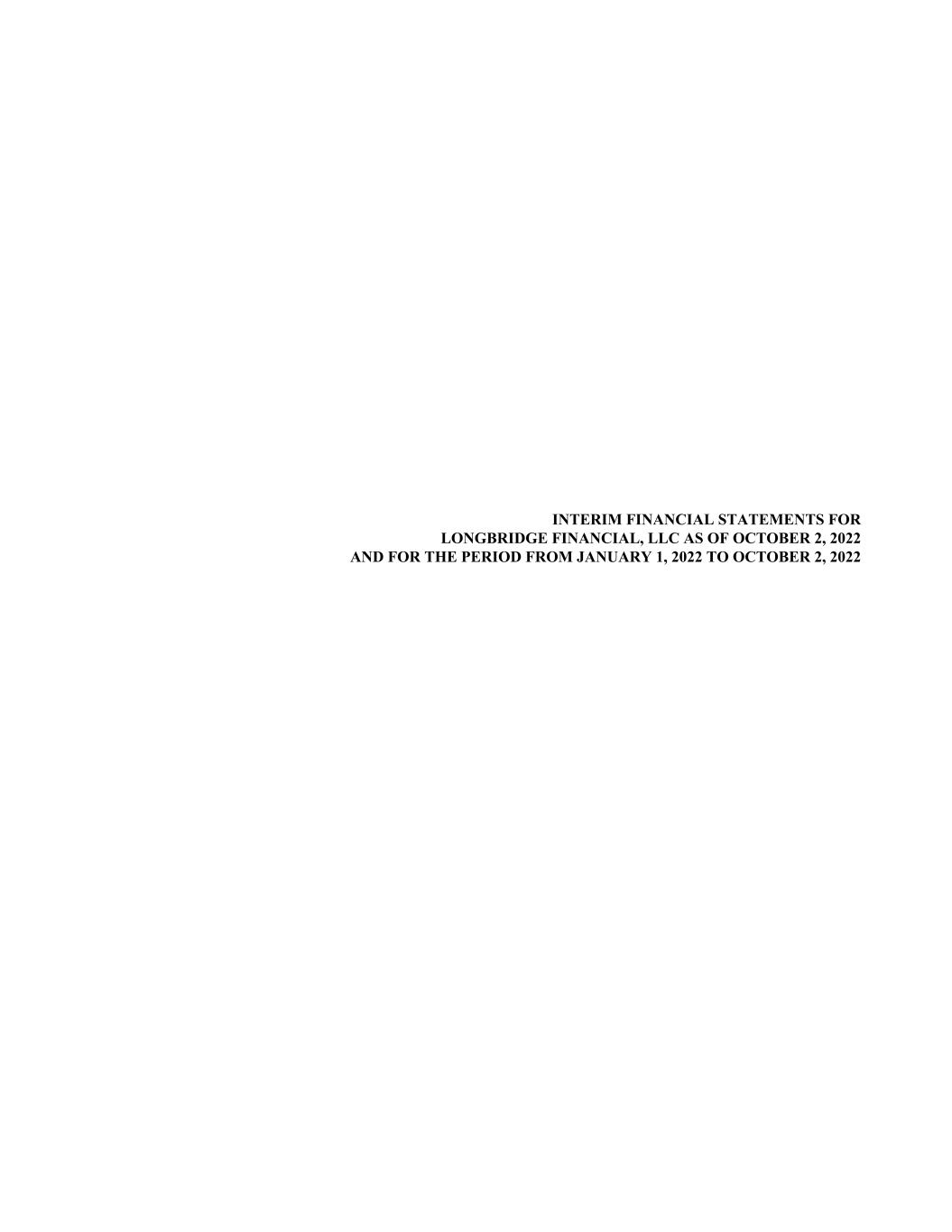
INTERIM FINANCIAL STATEMENTS FOR LONGBRIDGE FINANCIAL, LLC AS OF OCTOBER 2, 2022 AND FOR THE PERIOD FROM JANUARY 1, 2022 TO OCTOBER 2, 2022

Page Financial Statements Report of Independent Registered Public Accounting Firm 3 Balance Sheets 5 Statements of Operations 6 Statements of Changes in Members’ Equity 7 Statements of Cash Flows 8 Notes to Financial Statements 9

PricewaterhouseCoopers LLP, 2121 N. Pearl Street, Suite 2000, Dallas, Texas 75201 T: (214) 999 1400, www.pwc.com/us Report of Independent Auditors To the Board of Directors of Longbridge Financial LLC Opinion We have audited the accompanying financial statements of Longbridge Financial, LLC (the “Company”), which comprise the balance sheet as of October 2, 2022 and the related statement of operations, statements of changes in member’s equity, and Statement of Cash flows for the period of January 1, 2022 to October 2, 2022, including the related notes (collectively referred to as the “ financial statements”). In our opinion, the accompanying financial statements present fairly, in all material respects, the financial position of the Company as of October 2, 2022, and the results of its operations and its cash flows for the period of January 1, 2022 to October 2, 2022 in accordance with accounting principles generally accepted in the United States of America. Basis for Opinion We conducted our audit in accordance with auditing standards generally accepted in the United States of America (US GAAS). Our responsibilities under those standards are further described in the Auditors’ Responsibilities for the Audit of the Financial Statements section of our report. We are required to be independent of the Company and to meet our other ethical responsibilities, in accordance with the relevant ethical requirements relating to our audit. We believe that the audit evidence we have obtained is sufficient and appropriate to provide a basis for our audit opinion. Responsibilities of Management for the Financial Statements Management is responsible for the preparation and fair presentation of the financial statements in accordance with accounting principles generally accepted in the United States of America, and for the design, implementation, and maintenance of internal control relevant to the preparation and fair presentation of financial statements that are free from material misstatement, whether due to fraud or error. In preparing the financial statements, management is required to evaluate whether there are conditions or events, considered in the aggregate, that raise substantial doubt about the Company’s ability to continue as a going concern for one year after the date the financial statements are available to be issued. Auditors’ Responsibilities for the Audit of the Financial Statements Our objectives are to obtain reasonable assurance about whether the financial statements as a whole are free from material misstatement, whether due to fraud or error, and to issue an auditors’ report that includes our opinion. Reasonable assurance is a high level of assurance but is not absolute assurance and therefore is not a guarantee that an audit conducted in accordance with US GAAS will always detect a material misstatement when it exists. The risk of not detecting a material misstatement resulting from fraud is higher than for one resulting from error, as fraud may involve collusion, forgery, intentional omissions, misrepresentations, or the override of internal control. Misstatements are considered material
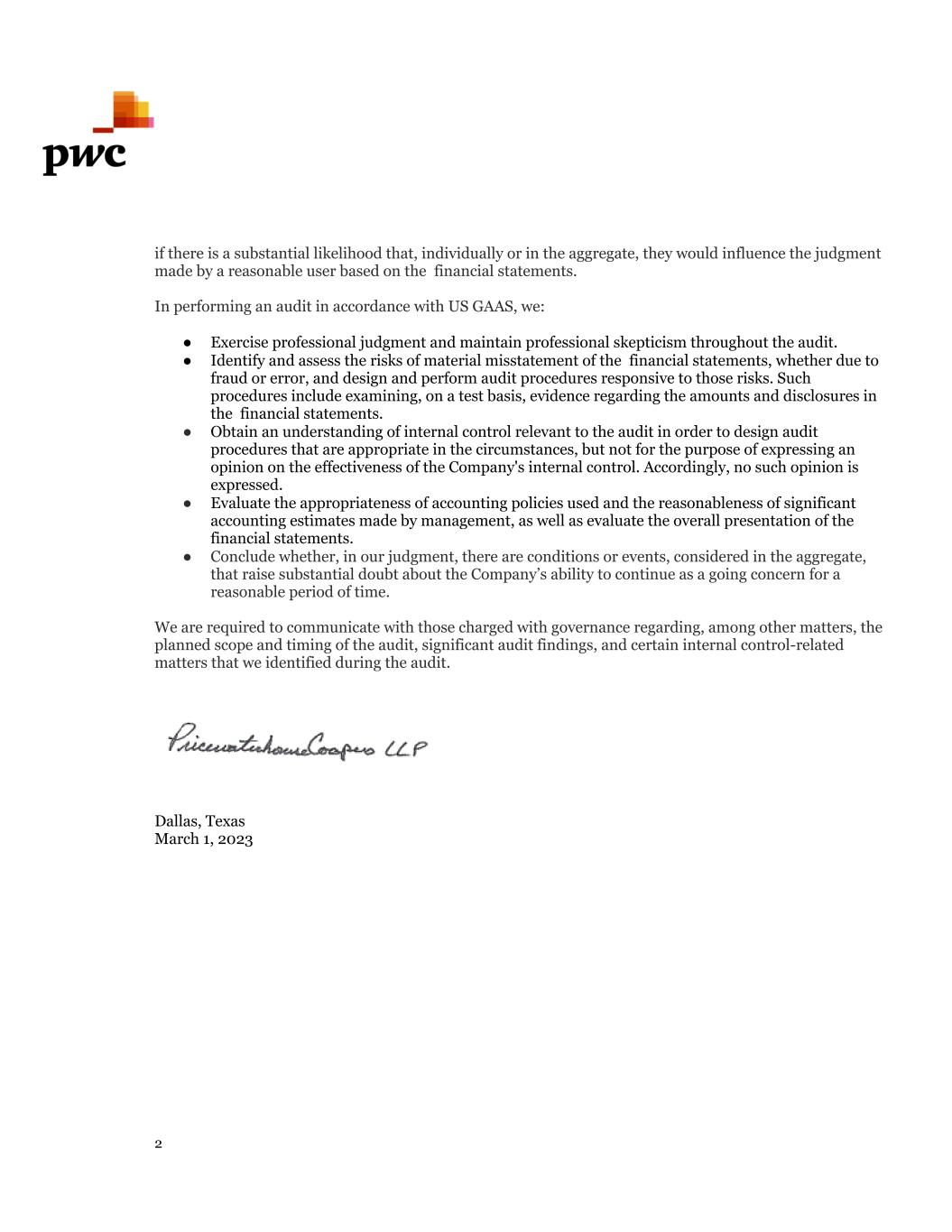
2 if there is a substantial likelihood that, individually or in the aggregate, they would influence the judgment made by a reasonable user based on the financial statements. In performing an audit in accordance with US GAAS, we: ● Exercise professional judgment and maintain professional skepticism throughout the audit. ● Identify and assess the risks of material misstatement of the financial statements, whether due to fraud or error, and design and perform audit procedures responsive to those risks. Such procedures include examining, on a test basis, evidence regarding the amounts and disclosures in the financial statements. ● Obtain an understanding of internal control relevant to the audit in order to design audit procedures that are appropriate in the circumstances, but not for the purpose of expressing an opinion on the effectiveness of the Company's internal control. Accordingly, no such opinion is expressed. ● Evaluate the appropriateness of accounting policies used and the reasonableness of significant accounting estimates made by management, as well as evaluate the overall presentation of the financial statements. ● Conclude whether, in our judgment, there are conditions or events, considered in the aggregate, that raise substantial doubt about the Company’s ability to continue as a going concern for a reasonable period of time. We are required to communicate with those charged with governance regarding, among other matters, the planned scope and timing of the audit, significant audit findings, and certain internal control-related matters that we identified during the audit. Dallas, Texas March 1, 2023
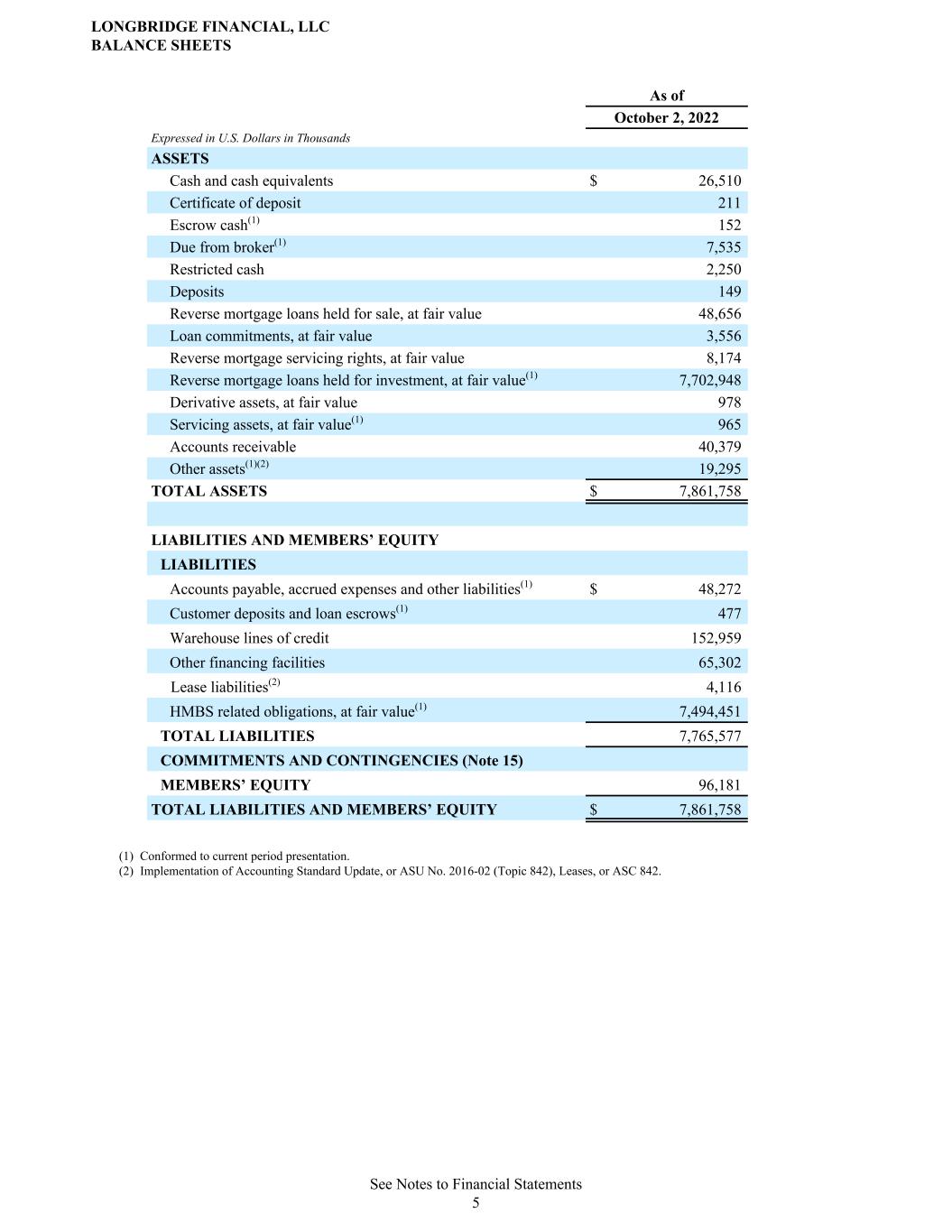
As of October 2, 2022 Expressed in U.S. Dollars in Thousands ASSETS Cash and cash equivalents $ 26,510 Certificate of deposit 211 Escrow cash(1) 152 Due from broker(1) 7,535 Restricted cash 2,250 Deposits 149 Reverse mortgage loans held for sale, at fair value 48,656 Loan commitments, at fair value 3,556 Reverse mortgage servicing rights, at fair value 8,174 Reverse mortgage loans held for investment, at fair value(1) 7,702,948 Derivative assets, at fair value 978 Servicing assets, at fair value(1) 965 Accounts receivable 40,379 Other assets(1)(2) 19,295 TOTAL ASSETS $ 7,861,758 LIABILITIES AND MEMBERS’ EQUITY LIABILITIES Accounts payable, accrued expenses and other liabilities(1) $ 48,272 Customer deposits and loan escrows(1) 477 Warehouse lines of credit 152,959 Other financing facilities 65,302 Lease liabilities(2) 4,116 HMBS related obligations, at fair value(1) 7,494,451 TOTAL LIABILITIES 7,765,577 COMMITMENTS AND CONTINGENCIES (Note 15) MEMBERS’ EQUITY 96,181 TOTAL LIABILITIES AND MEMBERS’ EQUITY $ 7,861,758 (1) Conformed to current period presentation. (2) Implementation of Accounting Standard Update, or ASU No. 2016-02 (Topic 842), Leases, or ASC 842. LONGBRIDGE FINANCIAL, LLC BALANCE SHEETS See Notes to Financial Statements 5
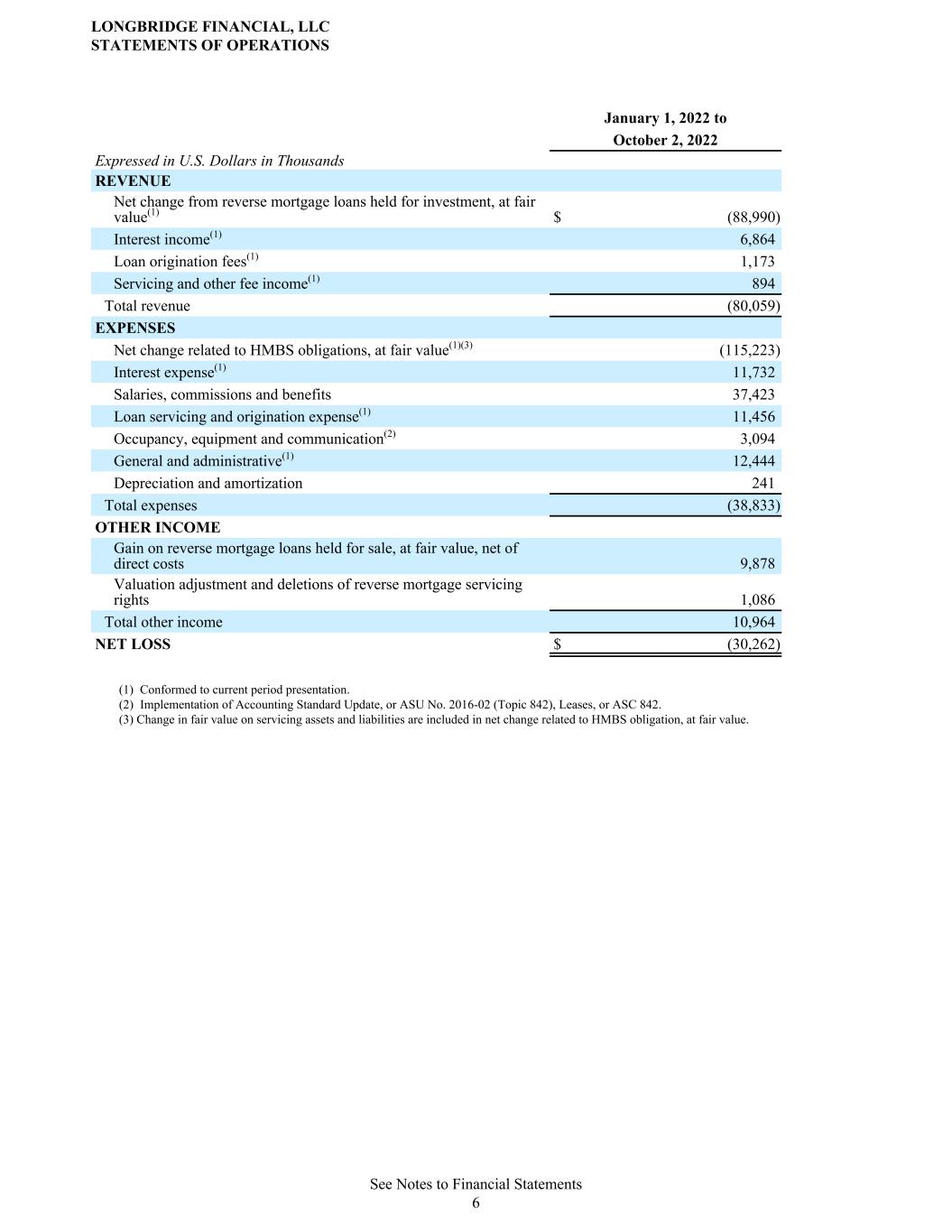
January 1, 2022 to October 2, 2022 Expressed in U.S. Dollars in Thousands REVENUE Net change from reverse mortgage loans held for investment, at fair value(1) $ (88,990) Interest income(1) 6,864 Loan origination fees(1) 1,173 Servicing and other fee income(1) 894 Total revenue (80,059) EXPENSES Net change related to HMBS obligations, at fair value(1)(3) (115,223) Interest expense(1) 11,732 Salaries, commissions and benefits 37,423 Loan servicing and origination expense(1) 11,456 Occupancy, equipment and communication(2) 3,094 General and administrative(1) 12,444 Depreciation and amortization 241 Total expenses (38,833) OTHER INCOME Gain on reverse mortgage loans held for sale, at fair value, net of direct costs 9,878 Valuation adjustment and deletions of reverse mortgage servicing rights 1,086 Total other income 10,964 NET LOSS $ (30,262) (1) Conformed to current period presentation. (2) Implementation of Accounting Standard Update, or ASU No. 2016-02 (Topic 842), Leases, or ASC 842. (3) Change in fair value on servicing assets and liabilities are included in net change related to HMBS obligation, at fair value. LONGBRIDGE FINANCIAL, LLC STATEMENTS OF OPERATIONS See Notes to Financial Statements 6
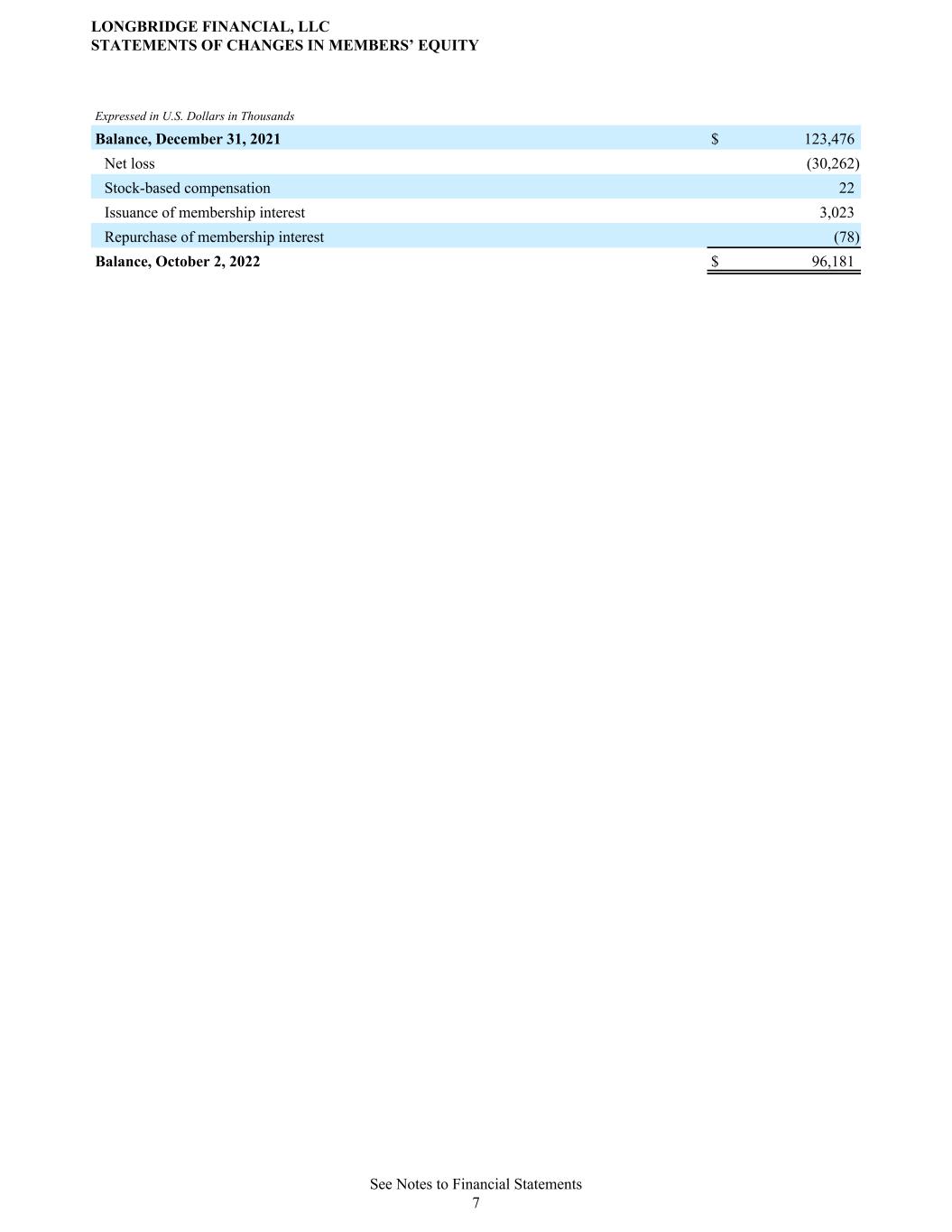
Expressed in U.S. Dollars in Thousands Balance, December 31, 2021 $ 123,476 Net loss (30,262) Stock-based compensation 22 Issuance of membership interest 3,023 Repurchase of membership interest (78) Balance, October 2, 2022 $ 96,181 LONGBRIDGE FINANCIAL, LLC STATEMENTS OF CHANGES IN MEMBERS’ EQUITY See Notes to Financial Statements 7
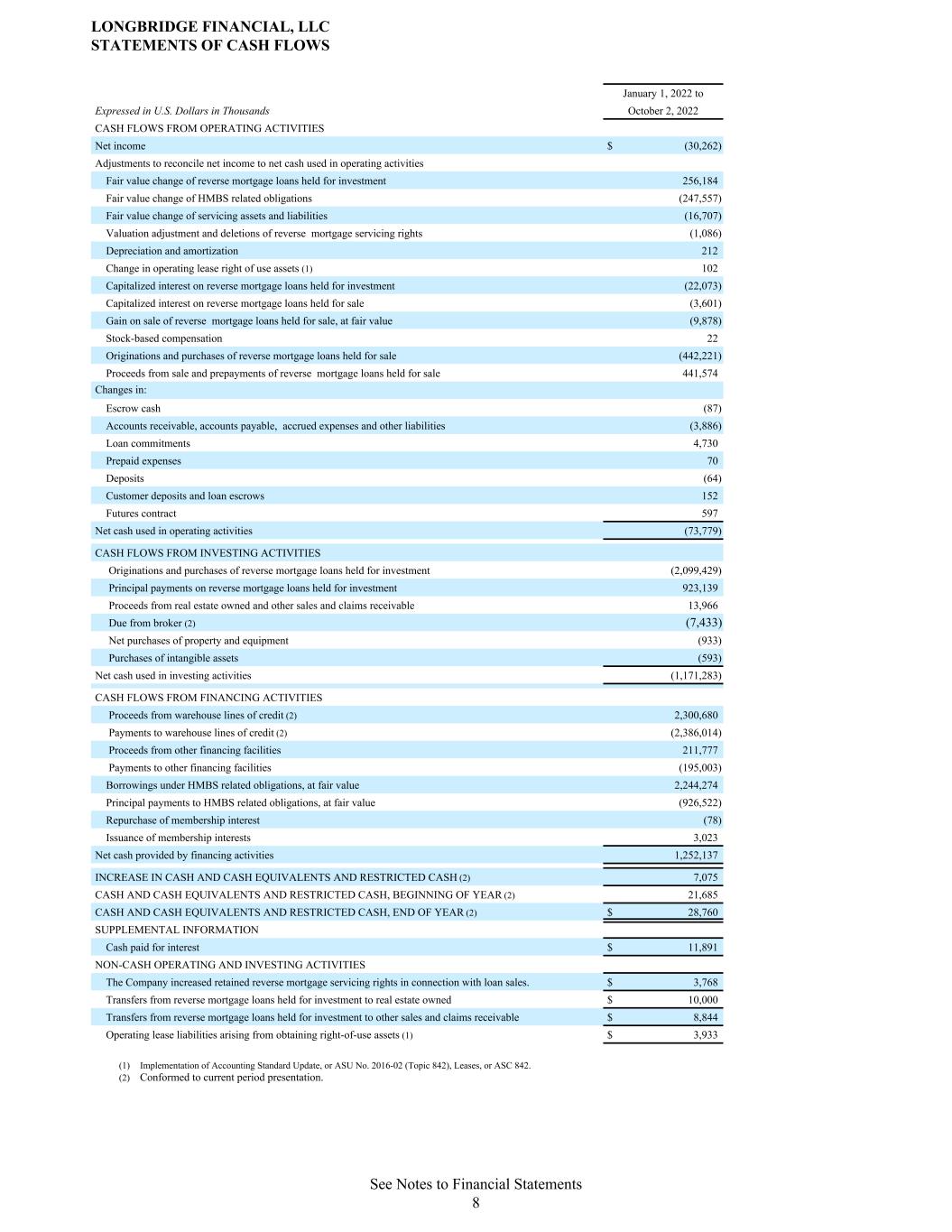
January 1, 2022 to Expressed in U.S. Dollars in Thousands October 2, 2022 CASH FLOWS FROM OPERATING ACTIVITIES Net income $ (30,262) Adjustments to reconcile net income to net cash used in operating activities Fair value change of reverse mortgage loans held for investment 256,184 Fair value change of HMBS related obligations (247,557) Fair value change of servicing assets and liabilities (16,707) Valuation adjustment and deletions of reverse mortgage servicing rights (1,086) Depreciation and amortization 212 Change in operating lease right of use assets (1) 102 Capitalized interest on reverse mortgage loans held for investment (22,073) Capitalized interest on reverse mortgage loans held for sale (3,601) Gain on sale of reverse mortgage loans held for sale, at fair value (9,878) Stock-based compensation 22 Originations and purchases of reverse mortgage loans held for sale (442,221) Proceeds from sale and prepayments of reverse mortgage loans held for sale 441,574 Changes in: Escrow cash (87) Accounts receivable, accounts payable, accrued expenses and other liabilities (3,886) Loan commitments 4,730 Prepaid expenses 70 Deposits (64) Customer deposits and loan escrows 152 Futures contract 597 Net cash used in operating activities (73,779) CASH FLOWS FROM INVESTING ACTIVITIES Originations and purchases of reverse mortgage loans held for investment (2,099,429) Principal payments on reverse mortgage loans held for investment 923,139 Proceeds from real estate owned and other sales and claims receivable 13,966 Due from broker (2) (7,433) Net purchases of property and equipment (933) Purchases of intangible assets (593) Net cash used in investing activities (1,171,283) CASH FLOWS FROM FINANCING ACTIVITIES Proceeds from warehouse lines of credit (2) 2,300,680 Payments to warehouse lines of credit (2) (2,386,014) Proceeds from other financing facilities 211,777 Payments to other financing facilities (195,003) Borrowings under HMBS related obligations, at fair value 2,244,274 Principal payments to HMBS related obligations, at fair value (926,522) Repurchase of membership interest (78) Issuance of membership interests 3,023 Net cash provided by financing activities 1,252,137 INCREASE IN CASH AND CASH EQUIVALENTS AND RESTRICTED CASH (2) 7,075 CASH AND CASH EQUIVALENTS AND RESTRICTED CASH, BEGINNING OF YEAR (2) 21,685 CASH AND CASH EQUIVALENTS AND RESTRICTED CASH, END OF YEAR (2) $ 28,760 SUPPLEMENTAL INFORMATION Cash paid for interest $ 11,891 NON-CASH OPERATING AND INVESTING ACTIVITIES The Company increased retained reverse mortgage servicing rights in connection with loan sales. $ 3,768 Transfers from reverse mortgage loans held for investment to real estate owned $ 10,000 Transfers from reverse mortgage loans held for investment to other sales and claims receivable $ 8,844 Operating lease liabilities arising from obtaining right-of-use assets (1) $ 3,933 (1) Implementation of Accounting Standard Update, or ASU No. 2016-02 (Topic 842), Leases, or ASC 842. (2) Conformed to current period presentation. LONGBRIDGE FINANCIAL, LLC STATEMENTS OF CASH FLOWS See Notes to Financial Statements 8
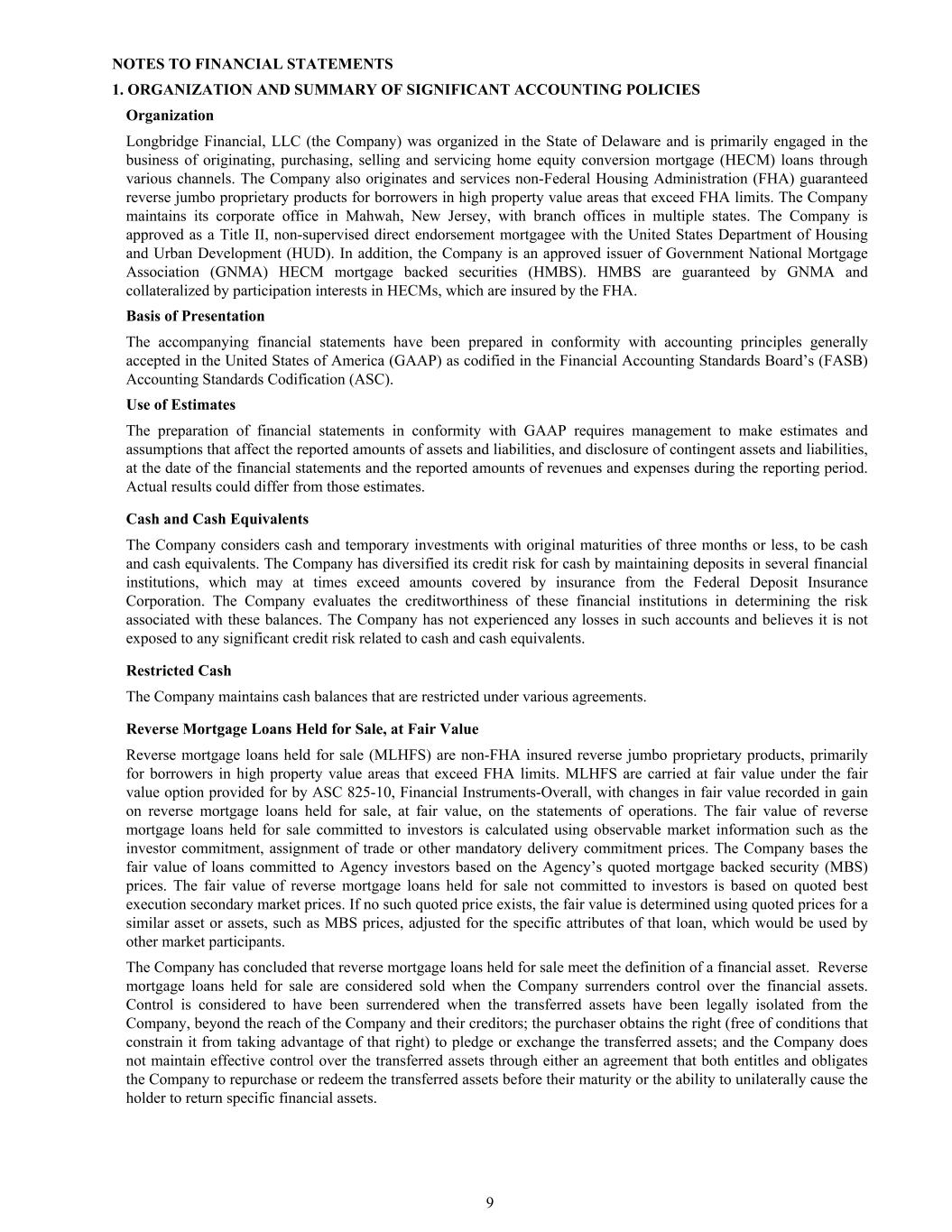
1. ORGANIZATION AND SUMMARY OF SIGNIFICANT ACCOUNTING POLICIES Organization Longbridge Financial, LLC (the Company) was organized in the State of Delaware and is primarily engaged in the business of originating, purchasing, selling and servicing home equity conversion mortgage (HECM) loans through various channels. The Company also originates and services non-Federal Housing Administration (FHA) guaranteed reverse jumbo proprietary products for borrowers in high property value areas that exceed FHA limits. The Company maintains its corporate office in Mahwah, New Jersey, with branch offices in multiple states. The Company is approved as a Title II, non-supervised direct endorsement mortgagee with the United States Department of Housing and Urban Development (HUD). In addition, the Company is an approved issuer of Government National Mortgage Association (GNMA) HECM mortgage backed securities (HMBS). HMBS are guaranteed by GNMA and collateralized by participation interests in HECMs, which are insured by the FHA. Basis of Presentation The accompanying financial statements have been prepared in conformity with accounting principles generally accepted in the United States of America (GAAP) as codified in the Financial Accounting Standards Board’s (FASB) Accounting Standards Codification (ASC). Use of Estimates The preparation of financial statements in conformity with GAAP requires management to make estimates and assumptions that affect the reported amounts of assets and liabilities, and disclosure of contingent assets and liabilities, at the date of the financial statements and the reported amounts of revenues and expenses during the reporting period. Actual results could differ from those estimates. Cash and Cash Equivalents The Company considers cash and temporary investments with original maturities of three months or less, to be cash and cash equivalents. The Company has diversified its credit risk for cash by maintaining deposits in several financial institutions, which may at times exceed amounts covered by insurance from the Federal Deposit Insurance Corporation. The Company evaluates the creditworthiness of these financial institutions in determining the risk associated with these balances. The Company has not experienced any losses in such accounts and believes it is not exposed to any significant credit risk related to cash and cash equivalents. Restricted Cash The Company maintains cash balances that are restricted under various agreements. Reverse Mortgage Loans Held for Sale, at Fair Value Reverse mortgage loans held for sale (MLHFS) are non-FHA insured reverse jumbo proprietary products, primarily for borrowers in high property value areas that exceed FHA limits. MLHFS are carried at fair value under the fair value option provided for by ASC 825-10, Financial Instruments-Overall, with changes in fair value recorded in gain on reverse mortgage loans held for sale, at fair value, on the statements of operations. The fair value of reverse mortgage loans held for sale committed to investors is calculated using observable market information such as the investor commitment, assignment of trade or other mandatory delivery commitment prices. The Company bases the fair value of loans committed to Agency investors based on the Agency’s quoted mortgage backed security (MBS) prices. The fair value of reverse mortgage loans held for sale not committed to investors is based on quoted best execution secondary market prices. If no such quoted price exists, the fair value is determined using quoted prices for a similar asset or assets, such as MBS prices, adjusted for the specific attributes of that loan, which would be used by other market participants. The Company has concluded that reverse mortgage loans held for sale meet the definition of a financial asset. Reverse mortgage loans held for sale are considered sold when the Company surrenders control over the financial assets. Control is considered to have been surrendered when the transferred assets have been legally isolated from the Company, beyond the reach of the Company and their creditors; the purchaser obtains the right (free of conditions that constrain it from taking advantage of that right) to pledge or exchange the transferred assets; and the Company does not maintain effective control over the transferred assets through either an agreement that both entitles and obligates the Company to repurchase or redeem the transferred assets before their maturity or the ability to unilaterally cause the holder to return specific financial assets. NOTES TO FINANCIAL STATEMENTS 9
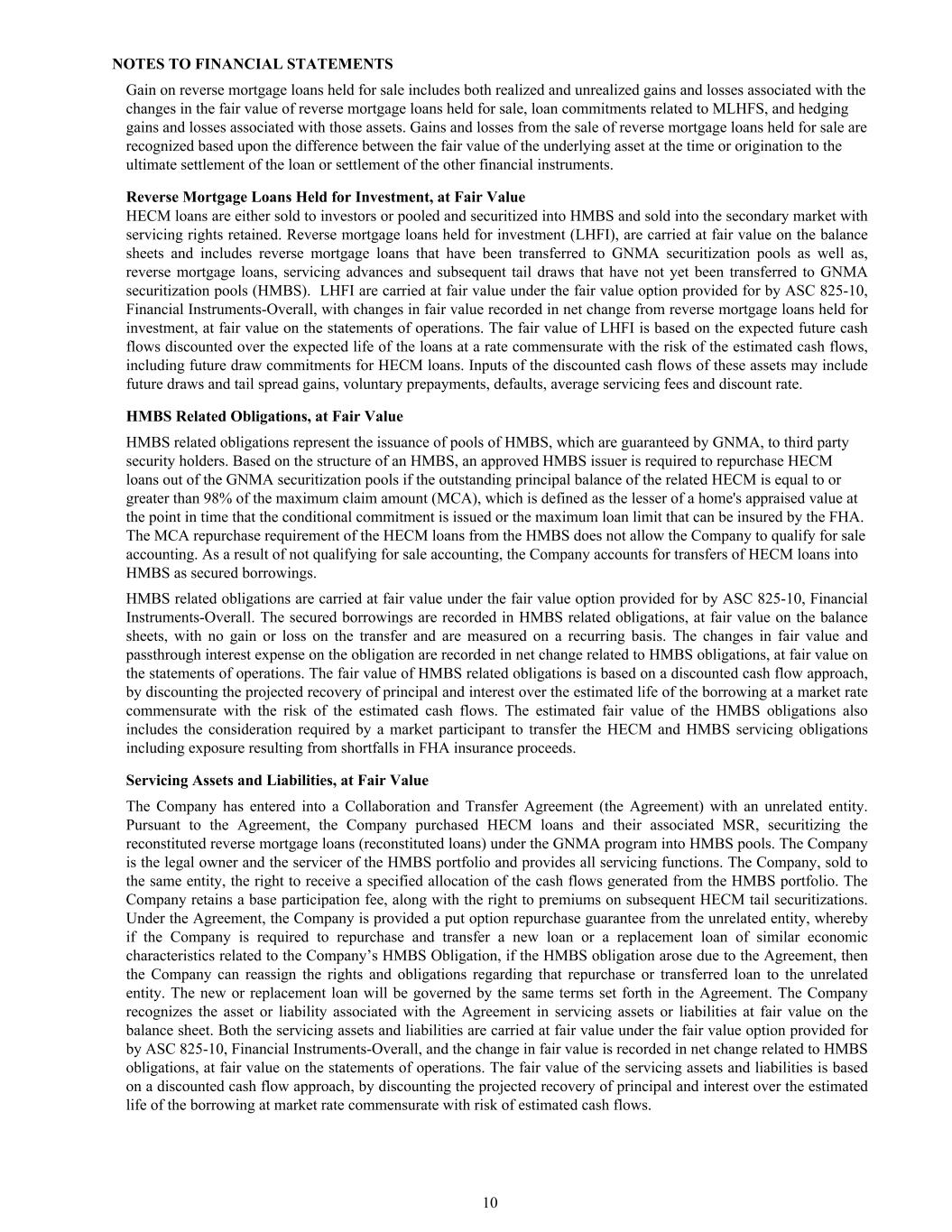
Gain on reverse mortgage loans held for sale includes both realized and unrealized gains and losses associated with the changes in the fair value of reverse mortgage loans held for sale, loan commitments related to MLHFS, and hedging gains and losses associated with those assets. Gains and losses from the sale of reverse mortgage loans held for sale are recognized based upon the difference between the fair value of the underlying asset at the time or origination to the ultimate settlement of the loan or settlement of the other financial instruments. Reverse Mortgage Loans Held for Investment, at Fair Value HECM loans are either sold to investors or pooled and securitized into HMBS and sold into the secondary market with servicing rights retained. Reverse mortgage loans held for investment (LHFI), are carried at fair value on the balance sheets and includes reverse mortgage loans that have been transferred to GNMA securitization pools as well as, reverse mortgage loans, servicing advances and subsequent tail draws that have not yet been transferred to GNMA securitization pools (HMBS). LHFI are carried at fair value under the fair value option provided for by ASC 825-10, Financial Instruments-Overall, with changes in fair value recorded in net change from reverse mortgage loans held for investment, at fair value on the statements of operations. The fair value of LHFI is based on the expected future cash flows discounted over the expected life of the loans at a rate commensurate with the risk of the estimated cash flows, including future draw commitments for HECM loans. Inputs of the discounted cash flows of these assets may include future draws and tail spread gains, voluntary prepayments, defaults, average servicing fees and discount rate. HMBS Related Obligations, at Fair Value HMBS related obligations represent the issuance of pools of HMBS, which are guaranteed by GNMA, to third party security holders. Based on the structure of an HMBS, an approved HMBS issuer is required to repurchase HECM loans out of the GNMA securitization pools if the outstanding principal balance of the related HECM is equal to or greater than 98% of the maximum claim amount (MCA), which is defined as the lesser of a home's appraised value at the point in time that the conditional commitment is issued or the maximum loan limit that can be insured by the FHA. The MCA repurchase requirement of the HECM loans from the HMBS does not allow the Company to qualify for sale accounting. As a result of not qualifying for sale accounting, the Company accounts for transfers of HECM loans into HMBS as secured borrowings. HMBS related obligations are carried at fair value under the fair value option provided for by ASC 825-10, Financial Instruments-Overall. The secured borrowings are recorded in HMBS related obligations, at fair value on the balance sheets, with no gain or loss on the transfer and are measured on a recurring basis. The changes in fair value and passthrough interest expense on the obligation are recorded in net change related to HMBS obligations, at fair value on the statements of operations. The fair value of HMBS related obligations is based on a discounted cash flow approach, by discounting the projected recovery of principal and interest over the estimated life of the borrowing at a market rate commensurate with the risk of the estimated cash flows. The estimated fair value of the HMBS obligations also includes the consideration required by a market participant to transfer the HECM and HMBS servicing obligations including exposure resulting from shortfalls in FHA insurance proceeds. Servicing Assets and Liabilities, at Fair Value The Company has entered into a Collaboration and Transfer Agreement (the Agreement) with an unrelated entity. Pursuant to the Agreement, the Company purchased HECM loans and their associated MSR, securitizing the reconstituted reverse mortgage loans (reconstituted loans) under the GNMA program into HMBS pools. The Company is the legal owner and the servicer of the HMBS portfolio and provides all servicing functions. The Company, sold to the same entity, the right to receive a specified allocation of the cash flows generated from the HMBS portfolio. The Company retains a base participation fee, along with the right to premiums on subsequent HECM tail securitizations. Under the Agreement, the Company is provided a put option repurchase guarantee from the unrelated entity, whereby if the Company is required to repurchase and transfer a new loan or a replacement loan of similar economic characteristics related to the Company’s HMBS Obligation, if the HMBS obligation arose due to the Agreement, then the Company can reassign the rights and obligations regarding that repurchase or transferred loan to the unrelated entity. The new or replacement loan will be governed by the same terms set forth in the Agreement. The Company recognizes the asset or liability associated with the Agreement in servicing assets or liabilities at fair value on the balance sheet. Both the servicing assets and liabilities are carried at fair value under the fair value option provided for by ASC 825-10, Financial Instruments-Overall, and the change in fair value is recorded in net change related to HMBS obligations, at fair value on the statements of operations. The fair value of the servicing assets and liabilities is based on a discounted cash flow approach, by discounting the projected recovery of principal and interest over the estimated life of the borrowing at market rate commensurate with risk of estimated cash flows. NOTES TO FINANCIAL STATEMENTS 10
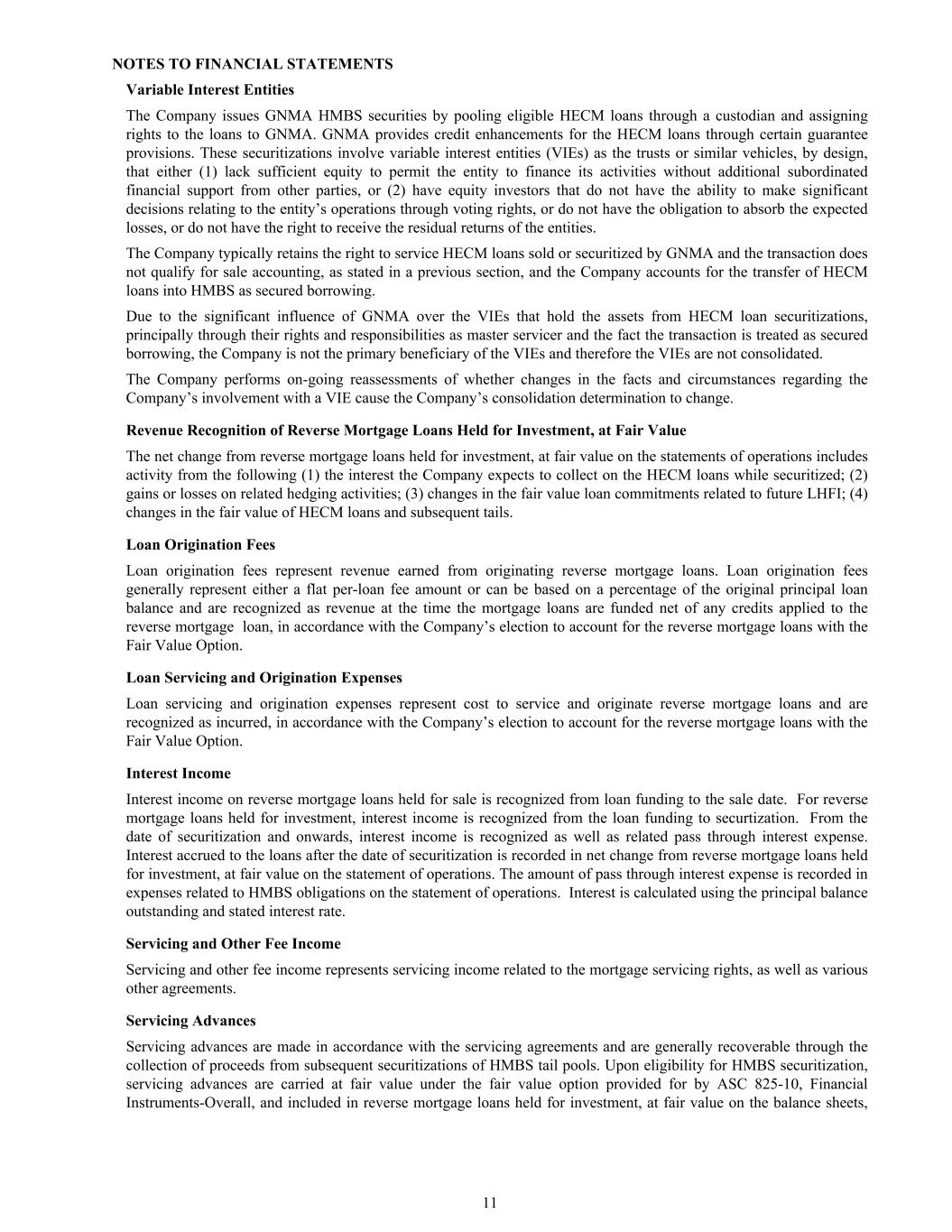
Variable Interest Entities The Company issues GNMA HMBS securities by pooling eligible HECM loans through a custodian and assigning rights to the loans to GNMA. GNMA provides credit enhancements for the HECM loans through certain guarantee provisions. These securitizations involve variable interest entities (VIEs) as the trusts or similar vehicles, by design, that either (1) lack sufficient equity to permit the entity to finance its activities without additional subordinated financial support from other parties, or (2) have equity investors that do not have the ability to make significant decisions relating to the entity’s operations through voting rights, or do not have the obligation to absorb the expected losses, or do not have the right to receive the residual returns of the entities. The Company typically retains the right to service HECM loans sold or securitized by GNMA and the transaction does not qualify for sale accounting, as stated in a previous section, and the Company accounts for the transfer of HECM loans into HMBS as secured borrowing. Due to the significant influence of GNMA over the VIEs that hold the assets from HECM loan securitizations, principally through their rights and responsibilities as master servicer and the fact the transaction is treated as secured borrowing, the Company is not the primary beneficiary of the VIEs and therefore the VIEs are not consolidated. The Company performs on-going reassessments of whether changes in the facts and circumstances regarding the Company’s involvement with a VIE cause the Company’s consolidation determination to change. Revenue Recognition of Reverse Mortgage Loans Held for Investment, at Fair Value The net change from reverse mortgage loans held for investment, at fair value on the statements of operations includes activity from the following (1) the interest the Company expects to collect on the HECM loans while securitized; (2) gains or losses on related hedging activities; (3) changes in the fair value loan commitments related to future LHFI; (4) changes in the fair value of HECM loans and subsequent tails. Loan Origination Fees Loan origination fees represent revenue earned from originating reverse mortgage loans. Loan origination fees generally represent either a flat per-loan fee amount or can be based on a percentage of the original principal loan balance and are recognized as revenue at the time the mortgage loans are funded net of any credits applied to the reverse mortgage loan, in accordance with the Company’s election to account for the reverse mortgage loans with the Fair Value Option. Loan Servicing and Origination Expenses Loan servicing and origination expenses represent cost to service and originate reverse mortgage loans and are recognized as incurred, in accordance with the Company’s election to account for the reverse mortgage loans with the Fair Value Option. Interest Income Interest income on reverse mortgage loans held for sale is recognized from loan funding to the sale date. For reverse mortgage loans held for investment, interest income is recognized from the loan funding to securtization. From the date of securitization and onwards, interest income is recognized as well as related pass through interest expense. Interest accrued to the loans after the date of securitization is recorded in net change from reverse mortgage loans held for investment, at fair value on the statement of operations. The amount of pass through interest expense is recorded in expenses related to HMBS obligations on the statement of operations. Interest is calculated using the principal balance outstanding and stated interest rate. Servicing and Other Fee Income Servicing and other fee income represents servicing income related to the mortgage servicing rights, as well as various other agreements. Servicing Advances Servicing advances are made in accordance with the servicing agreements and are generally recoverable through the collection of proceeds from subsequent securitizations of HMBS tail pools. Upon eligibility for HMBS securitization, servicing advances are carried at fair value under the fair value option provided for by ASC 825-10, Financial Instruments-Overall, and included in reverse mortgage loans held for investment, at fair value on the balance sheets, NOTES TO FINANCIAL STATEMENTS 11
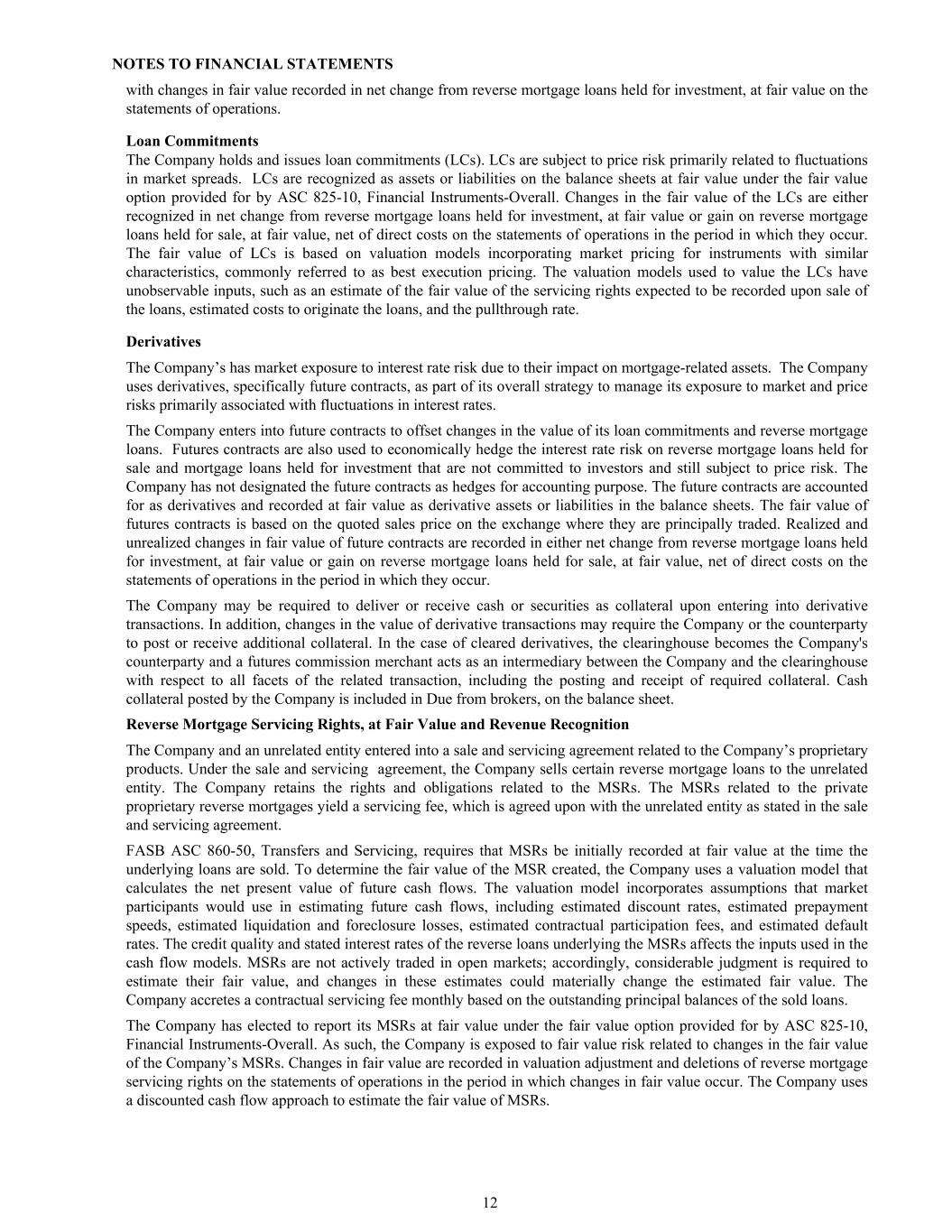
with changes in fair value recorded in net change from reverse mortgage loans held for investment, at fair value on the statements of operations. Loan Commitments The Company holds and issues loan commitments (LCs). LCs are subject to price risk primarily related to fluctuations in market spreads. LCs are recognized as assets or liabilities on the balance sheets at fair value under the fair value option provided for by ASC 825-10, Financial Instruments-Overall. Changes in the fair value of the LCs are either recognized in net change from reverse mortgage loans held for investment, at fair value or gain on reverse mortgage loans held for sale, at fair value, net of direct costs on the statements of operations in the period in which they occur. The fair value of LCs is based on valuation models incorporating market pricing for instruments with similar characteristics, commonly referred to as best execution pricing. The valuation models used to value the LCs have unobservable inputs, such as an estimate of the fair value of the servicing rights expected to be recorded upon sale of the loans, estimated costs to originate the loans, and the pullthrough rate. Derivatives The Company’s has market exposure to interest rate risk due to their impact on mortgage-related assets. The Company uses derivatives, specifically future contracts, as part of its overall strategy to manage its exposure to market and price risks primarily associated with fluctuations in interest rates. The Company enters into future contracts to offset changes in the value of its loan commitments and reverse mortgage loans. Futures contracts are also used to economically hedge the interest rate risk on reverse mortgage loans held for sale and mortgage loans held for investment that are not committed to investors and still subject to price risk. The Company has not designated the future contracts as hedges for accounting purpose. The future contracts are accounted for as derivatives and recorded at fair value as derivative assets or liabilities in the balance sheets. The fair value of futures contracts is based on the quoted sales price on the exchange where they are principally traded. Realized and unrealized changes in fair value of future contracts are recorded in either net change from reverse mortgage loans held for investment, at fair value or gain on reverse mortgage loans held for sale, at fair value, net of direct costs on the statements of operations in the period in which they occur. The Company may be required to deliver or receive cash or securities as collateral upon entering into derivative transactions. In addition, changes in the value of derivative transactions may require the Company or the counterparty to post or receive additional collateral. In the case of cleared derivatives, the clearinghouse becomes the Company's counterparty and a futures commission merchant acts as an intermediary between the Company and the clearinghouse with respect to all facets of the related transaction, including the posting and receipt of required collateral. Cash collateral posted by the Company is included in Due from brokers, on the balance sheet. Reverse Mortgage Servicing Rights, at Fair Value and Revenue Recognition The Company and an unrelated entity entered into a sale and servicing agreement related to the Company’s proprietary products. Under the sale and servicing agreement, the Company sells certain reverse mortgage loans to the unrelated entity. The Company retains the rights and obligations related to the MSRs. The MSRs related to the private proprietary reverse mortgages yield a servicing fee, which is agreed upon with the unrelated entity as stated in the sale and servicing agreement. FASB ASC 860-50, Transfers and Servicing, requires that MSRs be initially recorded at fair value at the time the underlying loans are sold. To determine the fair value of the MSR created, the Company uses a valuation model that calculates the net present value of future cash flows. The valuation model incorporates assumptions that market participants would use in estimating future cash flows, including estimated discount rates, estimated prepayment speeds, estimated liquidation and foreclosure losses, estimated contractual participation fees, and estimated default rates. The credit quality and stated interest rates of the reverse loans underlying the MSRs affects the inputs used in the cash flow models. MSRs are not actively traded in open markets; accordingly, considerable judgment is required to estimate their fair value, and changes in these estimates could materially change the estimated fair value. The Company accretes a contractual servicing fee monthly based on the outstanding principal balances of the sold loans. The Company has elected to report its MSRs at fair value under the fair value option provided for by ASC 825-10, Financial Instruments-Overall. As such, the Company is exposed to fair value risk related to changes in the fair value of the Company’s MSRs. Changes in fair value are recorded in valuation adjustment and deletions of reverse mortgage servicing rights on the statements of operations in the period in which changes in fair value occur. The Company uses a discounted cash flow approach to estimate the fair value of MSRs. NOTES TO FINANCIAL STATEMENTS 12
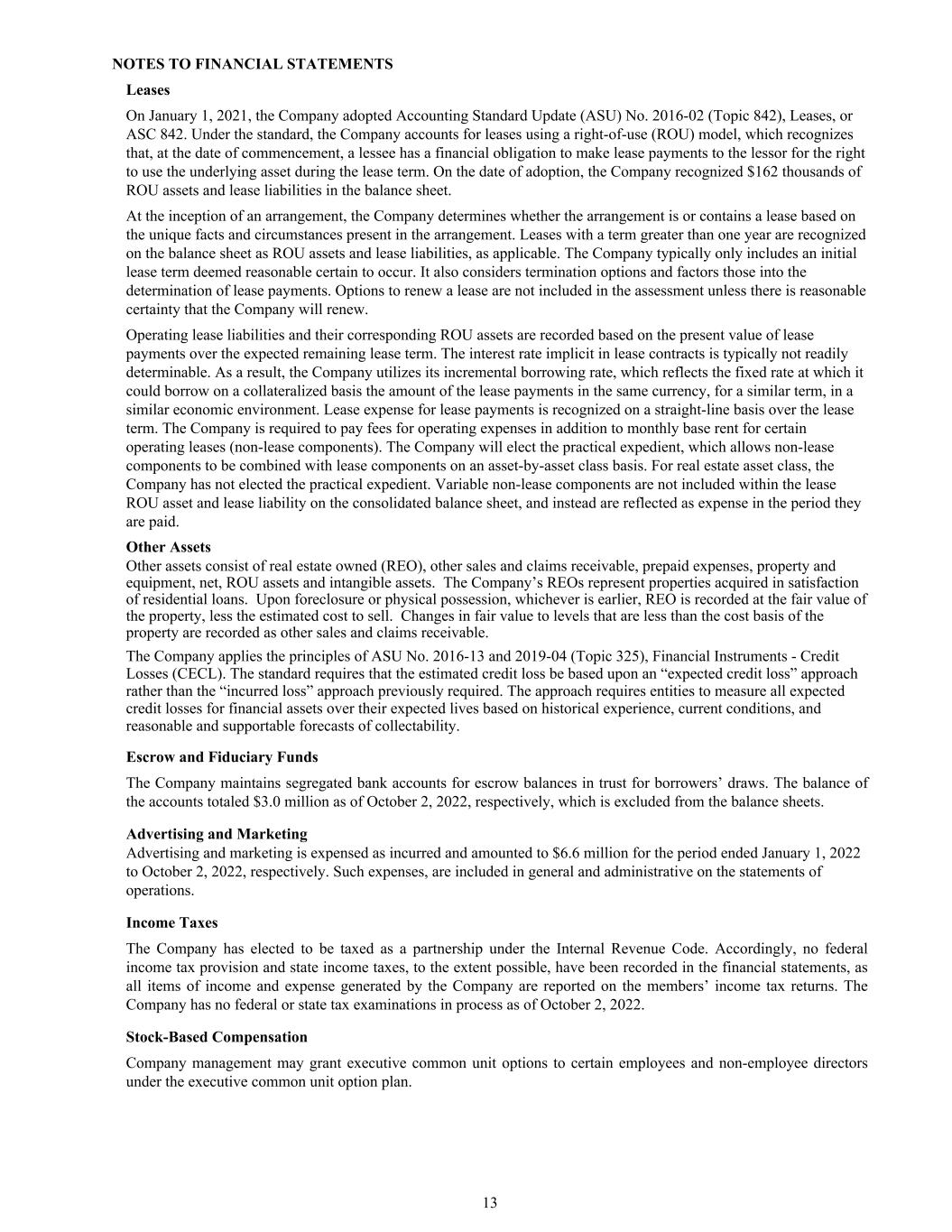
Leases On January 1, 2021, the Company adopted Accounting Standard Update (ASU) No. 2016-02 (Topic 842), Leases, or ASC 842. Under the standard, the Company accounts for leases using a right-of-use (ROU) model, which recognizes that, at the date of commencement, a lessee has a financial obligation to make lease payments to the lessor for the right to use the underlying asset during the lease term. On the date of adoption, the Company recognized $162 thousands of ROU assets and lease liabilities in the balance sheet. At the inception of an arrangement, the Company determines whether the arrangement is or contains a lease based on the unique facts and circumstances present in the arrangement. Leases with a term greater than one year are recognized on the balance sheet as ROU assets and lease liabilities, as applicable. The Company typically only includes an initial lease term deemed reasonable certain to occur. It also considers termination options and factors those into the determination of lease payments. Options to renew a lease are not included in the assessment unless there is reasonable certainty that the Company will renew. Operating lease liabilities and their corresponding ROU assets are recorded based on the present value of lease payments over the expected remaining lease term. The interest rate implicit in lease contracts is typically not readily determinable. As a result, the Company utilizes its incremental borrowing rate, which reflects the fixed rate at which it could borrow on a collateralized basis the amount of the lease payments in the same currency, for a similar term, in a similar economic environment. Lease expense for lease payments is recognized on a straight-line basis over the lease term. The Company is required to pay fees for operating expenses in addition to monthly base rent for certain operating leases (non-lease components). The Company will elect the practical expedient, which allows non-lease components to be combined with lease components on an asset-by-asset class basis. For real estate asset class, the Company has not elected the practical expedient. Variable non-lease components are not included within the lease ROU asset and lease liability on the consolidated balance sheet, and instead are reflected as expense in the period they are paid. Other Assets Other assets consist of real estate owned (REO), other sales and claims receivable, prepaid expenses, property and equipment, net, ROU assets and intangible assets. The Company’s REOs represent properties acquired in satisfaction of residential loans. Upon foreclosure or physical possession, whichever is earlier, REO is recorded at the fair value of the property, less the estimated cost to sell. Changes in fair value to levels that are less than the cost basis of the property are recorded as other sales and claims receivable. The Company applies the principles of ASU No. 2016-13 and 2019-04 (Topic 325), Financial Instruments - Credit Losses (CECL). The standard requires that the estimated credit loss be based upon an “expected credit loss” approach rather than the “incurred loss” approach previously required. The approach requires entities to measure all expected credit losses for financial assets over their expected lives based on historical experience, current conditions, and reasonable and supportable forecasts of collectability. Escrow and Fiduciary Funds The Company maintains segregated bank accounts for escrow balances in trust for borrowers’ draws. The balance of the accounts totaled $3.0 million as of October 2, 2022, respectively, which is excluded from the balance sheets. Advertising and Marketing Advertising and marketing is expensed as incurred and amounted to $6.6 million for the period ended January 1, 2022 to October 2, 2022, respectively. Such expenses, are included in general and administrative on the statements of operations. Income Taxes The Company has elected to be taxed as a partnership under the Internal Revenue Code. Accordingly, no federal income tax provision and state income taxes, to the extent possible, have been recorded in the financial statements, as all items of income and expense generated by the Company are reported on the members’ income tax returns. The Company has no federal or state tax examinations in process as of October 2, 2022. Stock-Based Compensation Company management may grant executive common unit options to certain employees and non-employee directors under the executive common unit option plan. NOTES TO FINANCIAL STATEMENTS 13
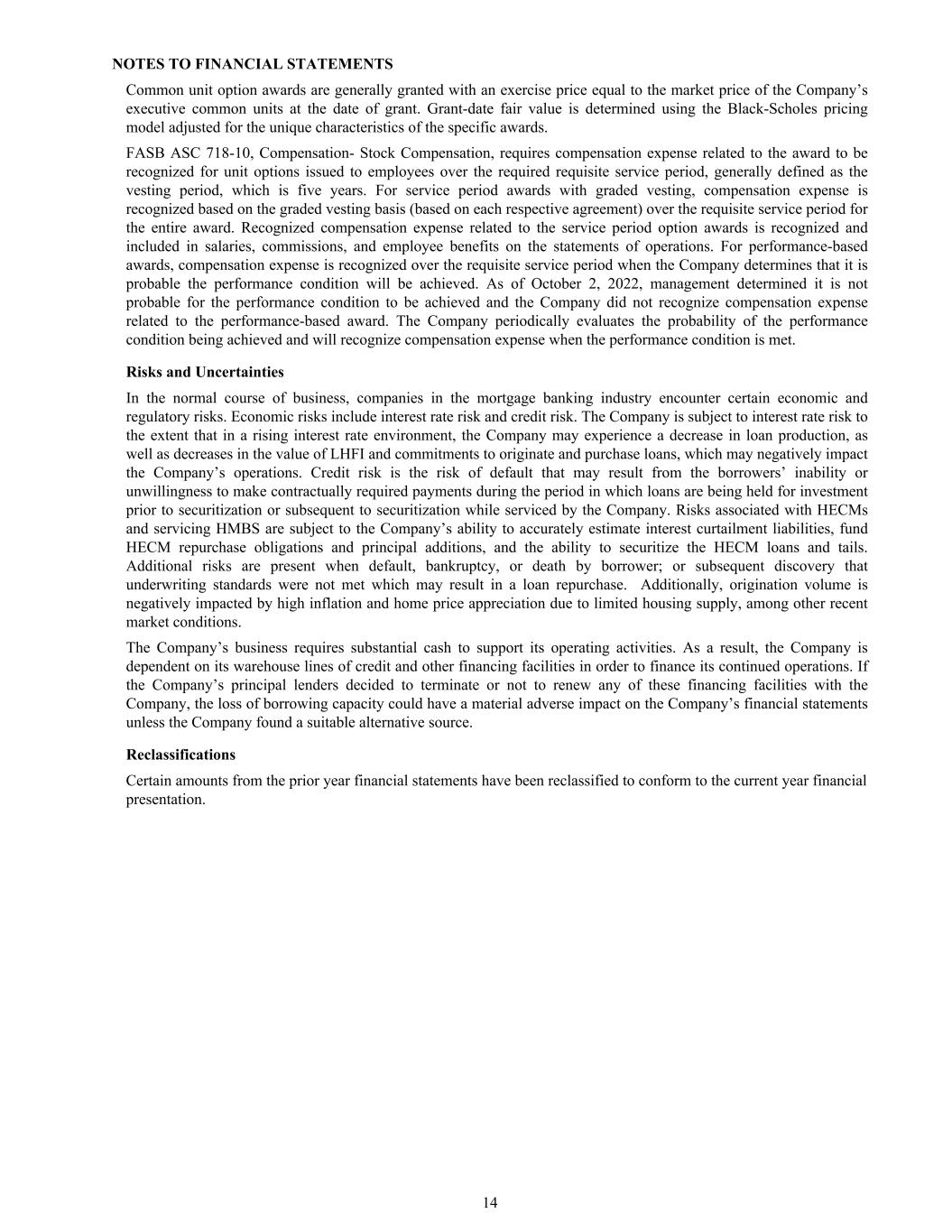
Common unit option awards are generally granted with an exercise price equal to the market price of the Company’s executive common units at the date of grant. Grant-date fair value is determined using the Black-Scholes pricing model adjusted for the unique characteristics of the specific awards. FASB ASC 718-10, Compensation- Stock Compensation, requires compensation expense related to the award to be recognized for unit options issued to employees over the required requisite service period, generally defined as the vesting period, which is five years. For service period awards with graded vesting, compensation expense is recognized based on the graded vesting basis (based on each respective agreement) over the requisite service period for the entire award. Recognized compensation expense related to the service period option awards is recognized and included in salaries, commissions, and employee benefits on the statements of operations. For performance-based awards, compensation expense is recognized over the requisite service period when the Company determines that it is probable the performance condition will be achieved. As of October 2, 2022, management determined it is not probable for the performance condition to be achieved and the Company did not recognize compensation expense related to the performance-based award. The Company periodically evaluates the probability of the performance condition being achieved and will recognize compensation expense when the performance condition is met. Risks and Uncertainties In the normal course of business, companies in the mortgage banking industry encounter certain economic and regulatory risks. Economic risks include interest rate risk and credit risk. The Company is subject to interest rate risk to the extent that in a rising interest rate environment, the Company may experience a decrease in loan production, as well as decreases in the value of LHFI and commitments to originate and purchase loans, which may negatively impact the Company’s operations. Credit risk is the risk of default that may result from the borrowers’ inability or unwillingness to make contractually required payments during the period in which loans are being held for investment prior to securitization or subsequent to securitization while serviced by the Company. Risks associated with HECMs and servicing HMBS are subject to the Company’s ability to accurately estimate interest curtailment liabilities, fund HECM repurchase obligations and principal additions, and the ability to securitize the HECM loans and tails. Additional risks are present when default, bankruptcy, or death by borrower; or subsequent discovery that underwriting standards were not met which may result in a loan repurchase. Additionally, origination volume is negatively impacted by high inflation and home price appreciation due to limited housing supply, among other recent market conditions. The Company’s business requires substantial cash to support its operating activities. As a result, the Company is dependent on its warehouse lines of credit and other financing facilities in order to finance its continued operations. If the Company’s principal lenders decided to terminate or not to renew any of these financing facilities with the Company, the loss of borrowing capacity could have a material adverse impact on the Company’s financial statements unless the Company found a suitable alternative source. Reclassifications Certain amounts from the prior year financial statements have been reclassified to conform to the current year financial presentation. NOTES TO FINANCIAL STATEMENTS 14
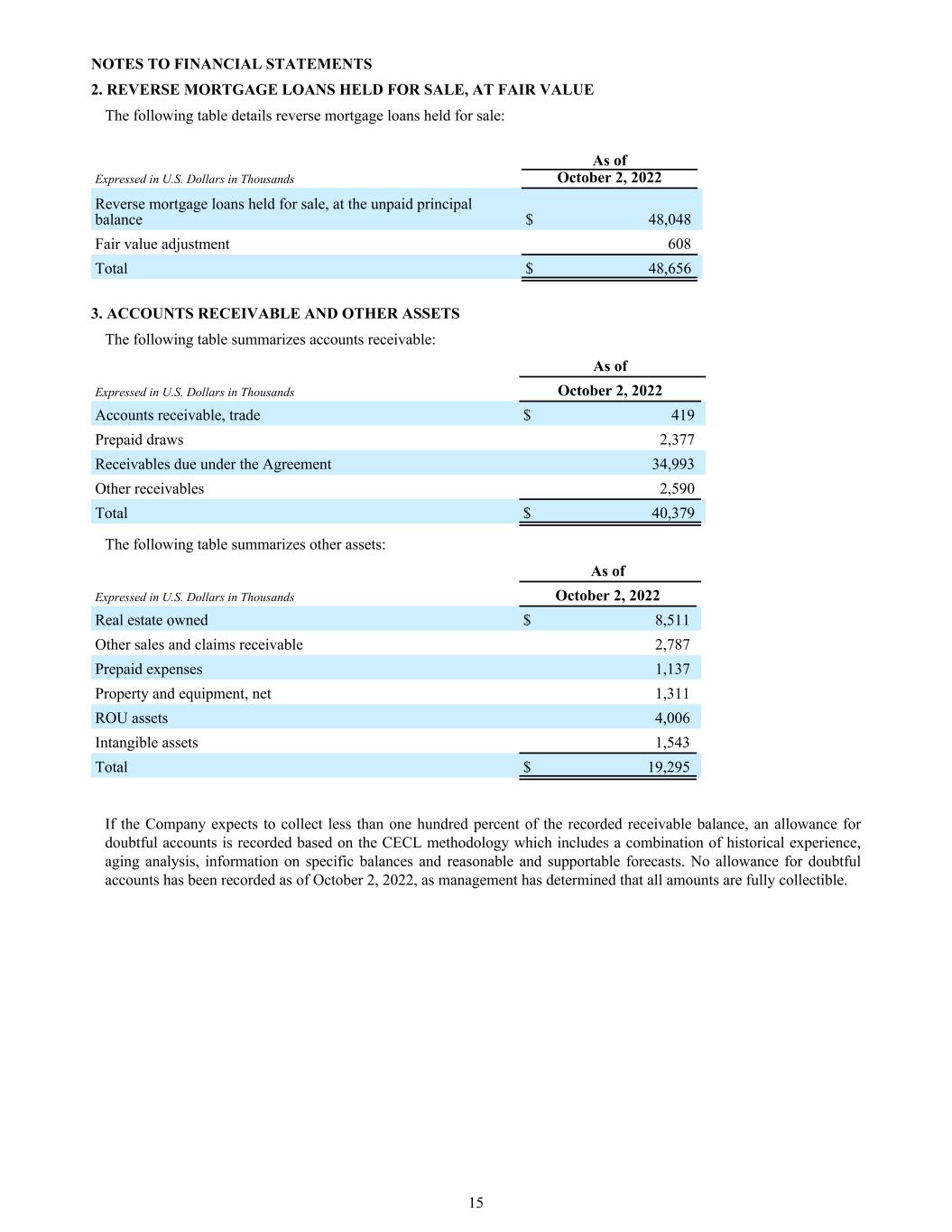
2. REVERSE MORTGAGE LOANS HELD FOR SALE, AT FAIR VALUE The following table details reverse mortgage loans held for sale: As of Expressed in U.S. Dollars in Thousands October 2, 2022 Reverse mortgage loans held for sale, at the unpaid principal balance $ 48,048 Fair value adjustment 608 Total $ 48,656 3. ACCOUNTS RECEIVABLE AND OTHER ASSETS The following table summarizes accounts receivable: As of Expressed in U.S. Dollars in Thousands October 2, 2022 Accounts receivable, trade $ 419 Prepaid draws 2,377 Receivables due under the Agreement 34,993 Other receivables 2,590 Total $ 40,379 The following table summarizes other assets: As of Expressed in U.S. Dollars in Thousands October 2, 2022 Real estate owned $ 8,511 Other sales and claims receivable 2,787 Prepaid expenses 1,137 Property and equipment, net 1,311 ROU assets 4,006 Intangible assets 1,543 Total $ 19,295 If the Company expects to collect less than one hundred percent of the recorded receivable balance, an allowance for doubtful accounts is recorded based on the CECL methodology which includes a combination of historical experience, aging analysis, information on specific balances and reasonable and supportable forecasts. No allowance for doubtful accounts has been recorded as of October 2, 2022, as management has determined that all amounts are fully collectible. NOTES TO FINANCIAL STATEMENTS 15
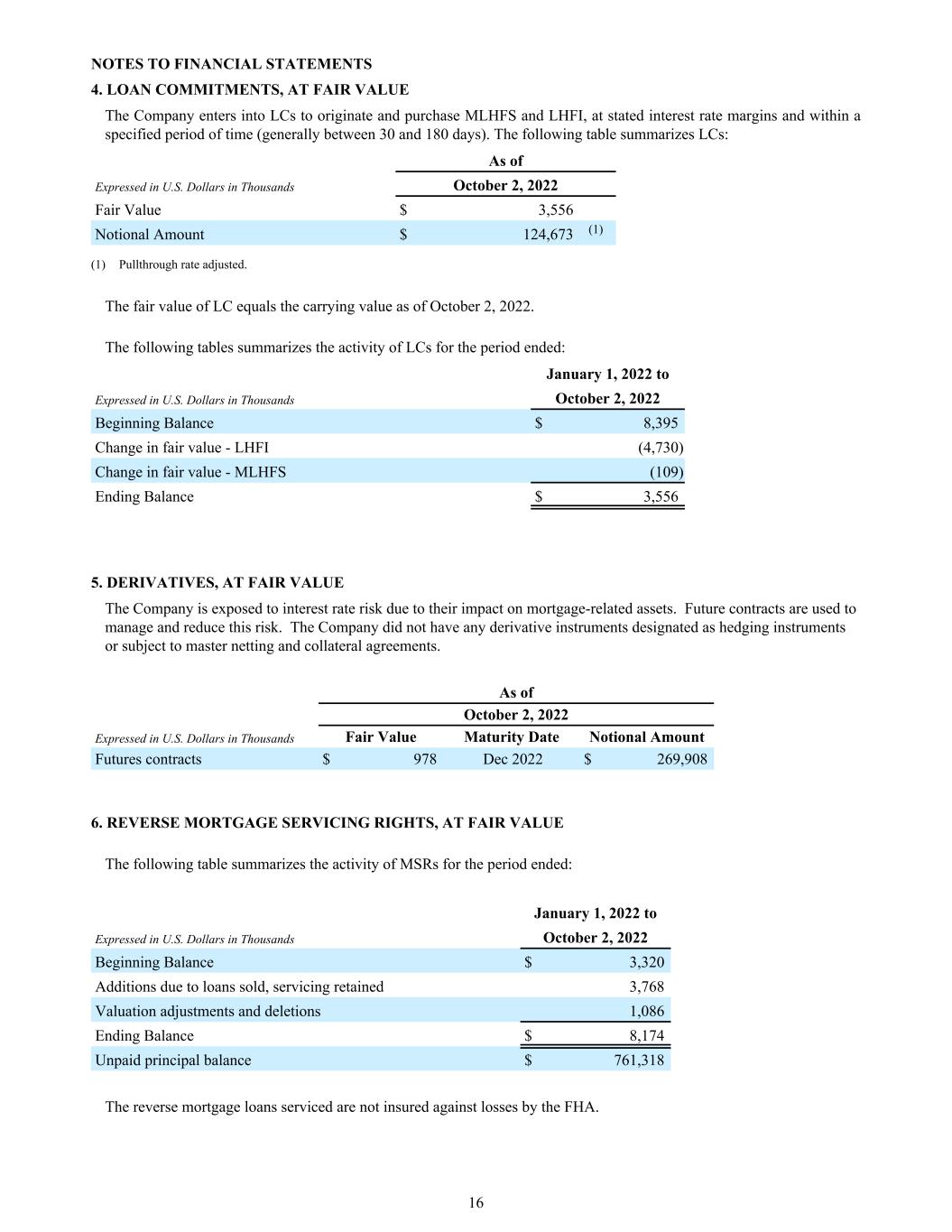
4. LOAN COMMITMENTS, AT FAIR VALUE The Company enters into LCs to originate and purchase MLHFS and LHFI, at stated interest rate margins and within a specified period of time (generally between 30 and 180 days). The following table summarizes LCs: As of Expressed in U.S. Dollars in Thousands October 2, 2022 Fair Value $ 3,556 Notional Amount $ 124,673 (1) (1) Pullthrough rate adjusted. The fair value of LC equals the carrying value as of October 2, 2022. The following tables summarizes the activity of LCs for the period ended: January 1, 2022 to Expressed in U.S. Dollars in Thousands October 2, 2022 Beginning Balance $ 8,395 Change in fair value - LHFI (4,730) Change in fair value - MLHFS (109) Ending Balance $ 3,556 5. DERIVATIVES, AT FAIR VALUE The Company is exposed to interest rate risk due to their impact on mortgage-related assets. Future contracts are used to manage and reduce this risk. The Company did not have any derivative instruments designated as hedging instruments or subject to master netting and collateral agreements. As of October 2, 2022 Expressed in U.S. Dollars in Thousands Fair Value Maturity Date Notional Amount Futures contracts $ 978 Dec 2022 $ 269,908 6. REVERSE MORTGAGE SERVICING RIGHTS, AT FAIR VALUE The following table summarizes the activity of MSRs for the period ended: January 1, 2022 to Expressed in U.S. Dollars in Thousands October 2, 2022 Beginning Balance $ 3,320 Additions due to loans sold, servicing retained 3,768 Valuation adjustments and deletions 1,086 Ending Balance $ 8,174 Unpaid principal balance $ 761,318 The reverse mortgage loans serviced are not insured against losses by the FHA. NOTES TO FINANCIAL STATEMENTS 16
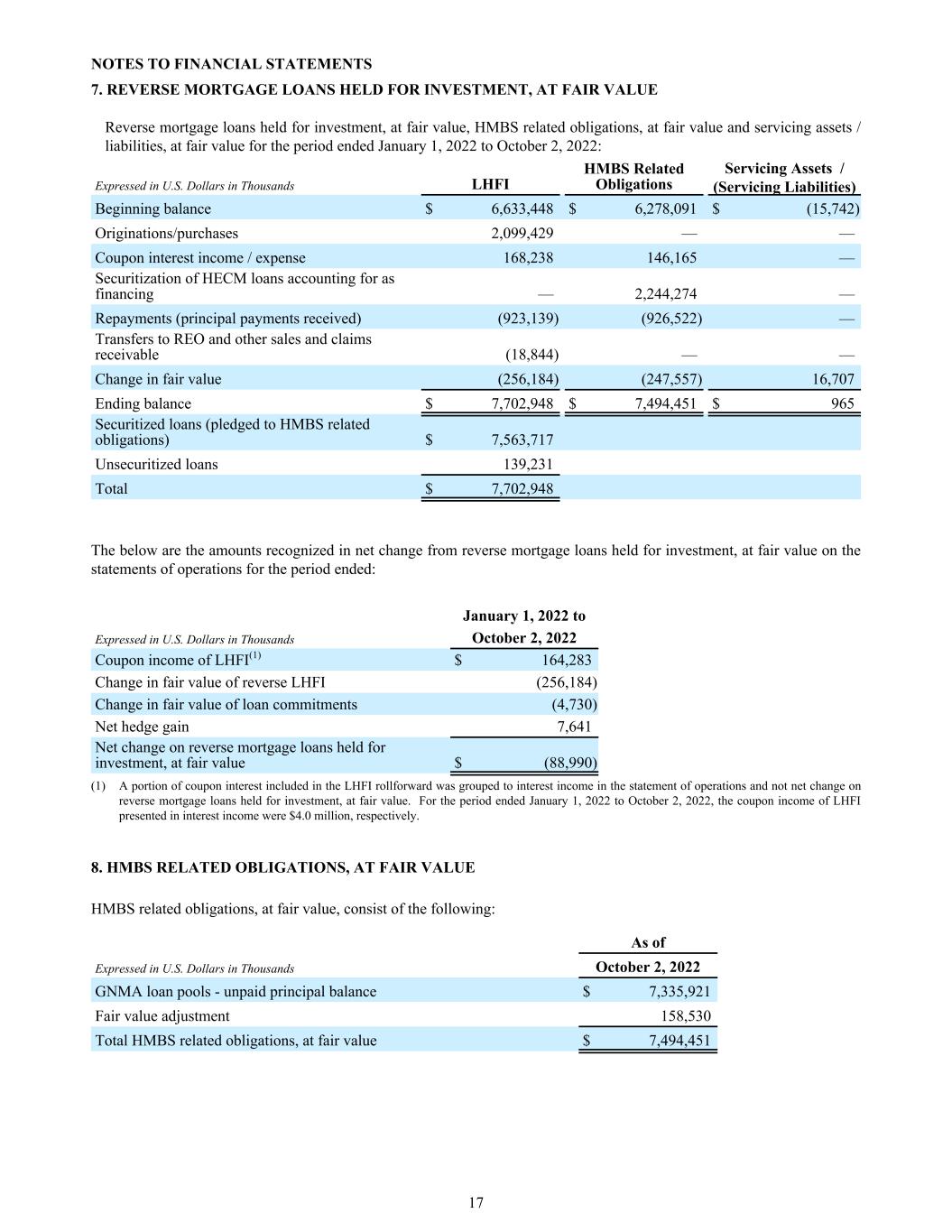
7. REVERSE MORTGAGE LOANS HELD FOR INVESTMENT, AT FAIR VALUE Reverse mortgage loans held for investment, at fair value, HMBS related obligations, at fair value and servicing assets / liabilities, at fair value for the period ended January 1, 2022 to October 2, 2022: Expressed in U.S. Dollars in Thousands LHFI HMBS Related Obligations Servicing Assets / (Servicing Liabilities) Beginning balance $ 6,633,448 $ 6,278,091 $ (15,742) Originations/purchases 2,099,429 — — Coupon interest income / expense 168,238 146,165 — Securitization of HECM loans accounting for as financing — 2,244,274 — Repayments (principal payments received) (923,139) (926,522) — Transfers to REO and other sales and claims receivable (18,844) — — Change in fair value (256,184) (247,557) 16,707 Ending balance $ 7,702,948 $ 7,494,451 $ 965 Securitized loans (pledged to HMBS related obligations) $ 7,563,717 Unsecuritized loans 139,231 Total $ 7,702,948 The below are the amounts recognized in net change from reverse mortgage loans held for investment, at fair value on the statements of operations for the period ended: January 1, 2022 to Expressed in U.S. Dollars in Thousands October 2, 2022 Coupon income of LHFI(1) $ 164,283 Change in fair value of reverse LHFI (256,184) Change in fair value of loan commitments (4,730) Net hedge gain 7,641 Net change on reverse mortgage loans held for investment, at fair value $ (88,990) (1) A portion of coupon interest included in the LHFI rollforward was grouped to interest income in the statement of operations and not net change on reverse mortgage loans held for investment, at fair value. For the period ended January 1, 2022 to October 2, 2022, the coupon income of LHFI presented in interest income were $4.0 million, respectively. 8. HMBS RELATED OBLIGATIONS, AT FAIR VALUE HMBS related obligations, at fair value, consist of the following: As of Expressed in U.S. Dollars in Thousands October 2, 2022 GNMA loan pools - unpaid principal balance $ 7,335,921 Fair value adjustment 158,530 Total HMBS related obligations, at fair value $ 7,494,451 NOTES TO FINANCIAL STATEMENTS 17
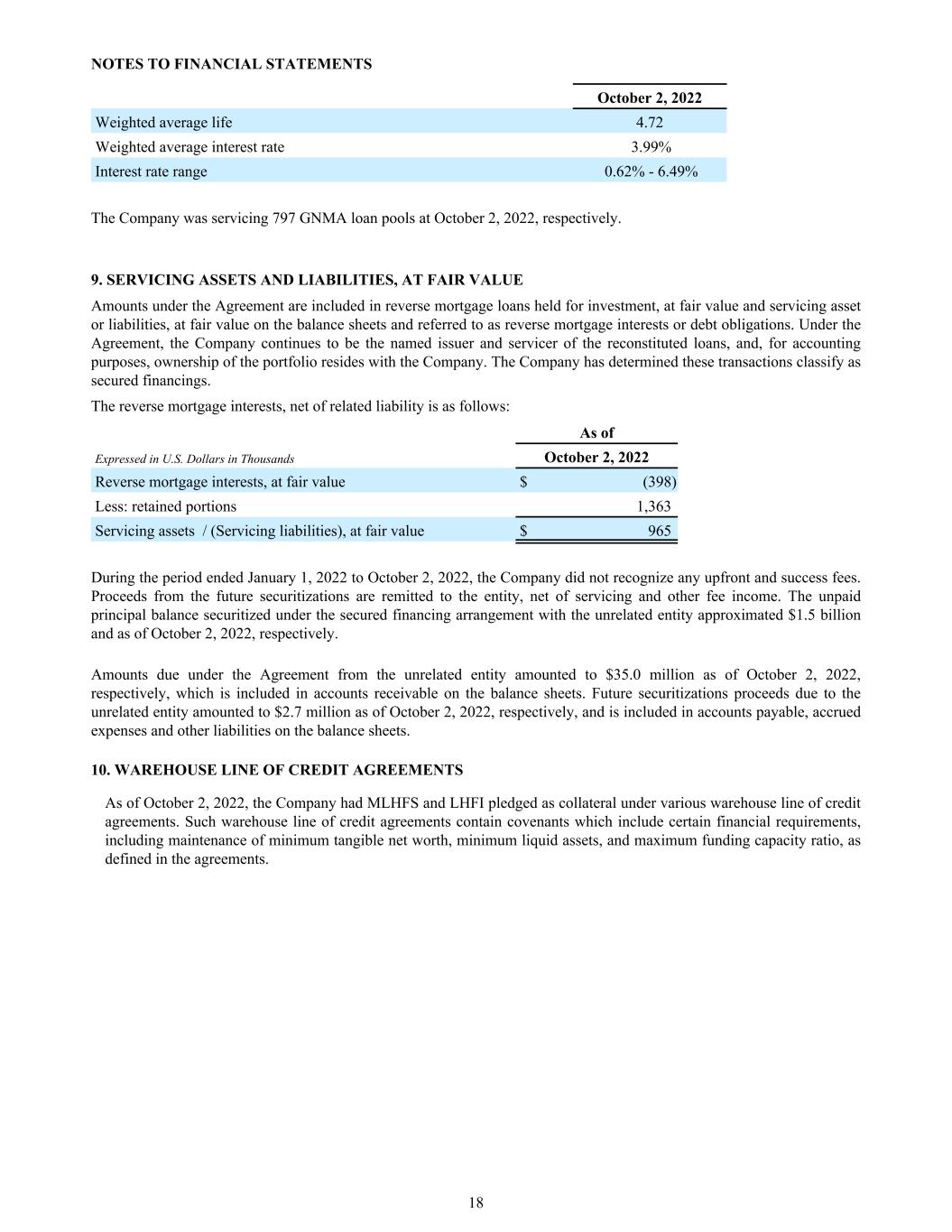
October 2, 2022 Weighted average life 4.72 Weighted average interest rate 3.99% Interest rate range 0.62% - 6.49% The Company was servicing 797 GNMA loan pools at October 2, 2022, respectively. 9. SERVICING ASSETS AND LIABILITIES, AT FAIR VALUE Amounts under the Agreement are included in reverse mortgage loans held for investment, at fair value and servicing asset or liabilities, at fair value on the balance sheets and referred to as reverse mortgage interests or debt obligations. Under the Agreement, the Company continues to be the named issuer and servicer of the reconstituted loans, and, for accounting purposes, ownership of the portfolio resides with the Company. The Company has determined these transactions classify as secured financings. The reverse mortgage interests, net of related liability is as follows: As of Expressed in U.S. Dollars in Thousands October 2, 2022 Reverse mortgage interests, at fair value $ (398) Less: retained portions 1,363 Servicing assets / (Servicing liabilities), at fair value $ 965 During the period ended January 1, 2022 to October 2, 2022, the Company did not recognize any upfront and success fees. Proceeds from the future securitizations are remitted to the entity, net of servicing and other fee income. The unpaid principal balance securitized under the secured financing arrangement with the unrelated entity approximated $1.5 billion and as of October 2, 2022, respectively. Amounts due under the Agreement from the unrelated entity amounted to $35.0 million as of October 2, 2022, respectively, which is included in accounts receivable on the balance sheets. Future securitizations proceeds due to the unrelated entity amounted to $2.7 million as of October 2, 2022, respectively, and is included in accounts payable, accrued expenses and other liabilities on the balance sheets. 10. WAREHOUSE LINE OF CREDIT AGREEMENTS As of October 2, 2022, the Company had MLHFS and LHFI pledged as collateral under various warehouse line of credit agreements. Such warehouse line of credit agreements contain covenants which include certain financial requirements, including maintenance of minimum tangible net worth, minimum liquid assets, and maximum funding capacity ratio, as defined in the agreements. NOTES TO FINANCIAL STATEMENTS 18
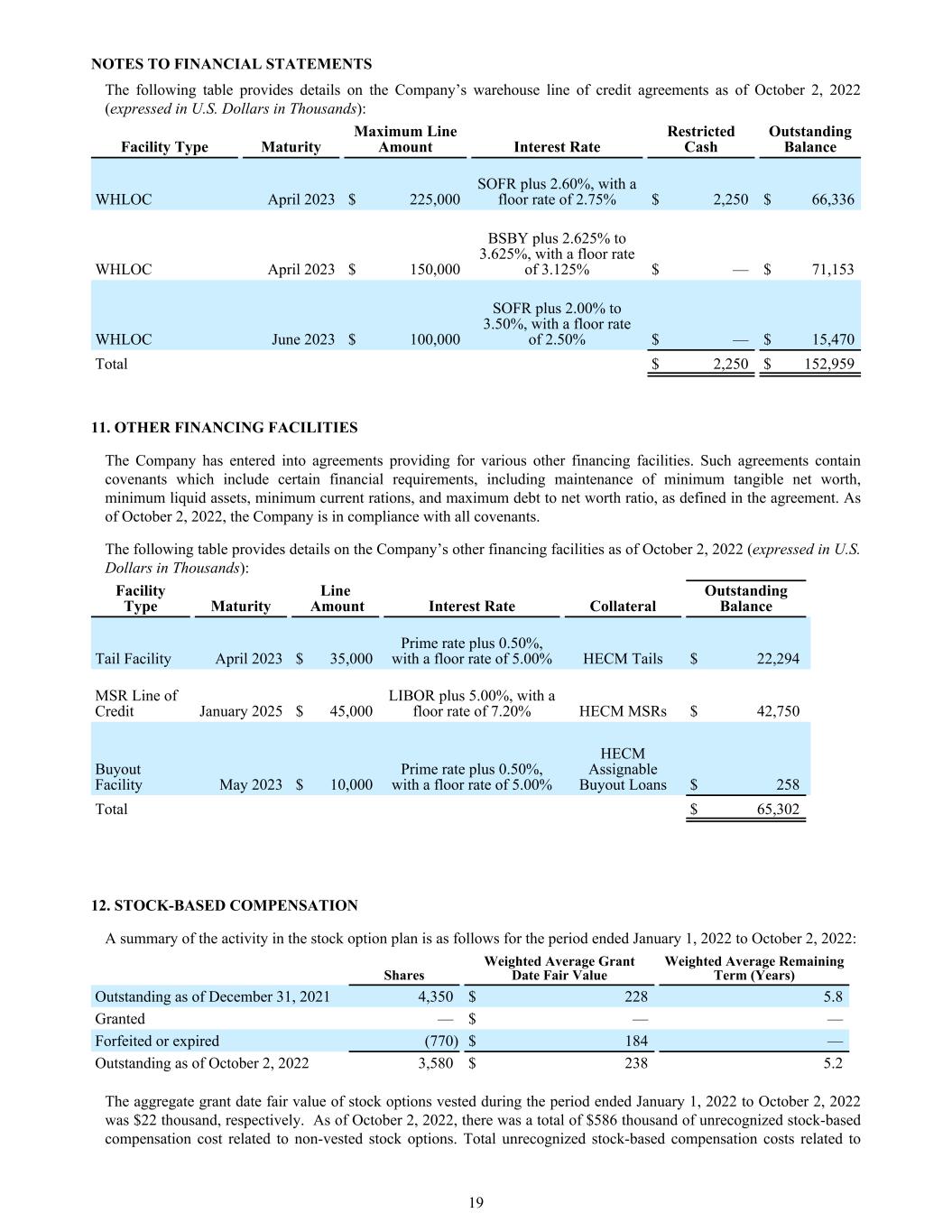
The following table provides details on the Company’s warehouse line of credit agreements as of October 2, 2022 (expressed in U.S. Dollars in Thousands): Facility Type Maturity Maximum Line Amount Interest Rate Restricted Cash Outstanding Balance WHLOC April 2023 $ 225,000 SOFR plus 2.60%, with a floor rate of 2.75% $ 2,250 $ 66,336 WHLOC April 2023 $ 150,000 BSBY plus 2.625% to 3.625%, with a floor rate of 3.125% $ — $ 71,153 WHLOC June 2023 $ 100,000 SOFR plus 2.00% to 3.50%, with a floor rate of 2.50% $ — $ 15,470 Total $ 2,250 $ 152,959 11. OTHER FINANCING FACILITIES The Company has entered into agreements providing for various other financing facilities. Such agreements contain covenants which include certain financial requirements, including maintenance of minimum tangible net worth, minimum liquid assets, minimum current rations, and maximum debt to net worth ratio, as defined in the agreement. As of October 2, 2022, the Company is in compliance with all covenants. The following table provides details on the Company’s other financing facilities as of October 2, 2022 (expressed in U.S. Dollars in Thousands): Facility Type Maturity Line Amount Interest Rate Collateral Outstanding Balance Tail Facility April 2023 $ 35,000 Prime rate plus 0.50%, with a floor rate of 5.00% HECM Tails $ 22,294 MSR Line of Credit January 2025 $ 45,000 LIBOR plus 5.00%, with a floor rate of 7.20% HECM MSRs $ 42,750 Buyout Facility May 2023 $ 10,000 Prime rate plus 0.50%, with a floor rate of 5.00% HECM Assignable Buyout Loans $ 258 Total $ 65,302 12. STOCK-BASED COMPENSATION A summary of the activity in the stock option plan is as follows for the period ended January 1, 2022 to October 2, 2022: Shares Weighted Average Grant Date Fair Value Weighted Average Remaining Term (Years) Outstanding as of December 31, 2021 4,350 $ 228 5.8 Granted — $ — — Forfeited or expired (770) $ 184 — Outstanding as of October 2, 2022 3,580 $ 238 5.2 The aggregate grant date fair value of stock options vested during the period ended January 1, 2022 to October 2, 2022 was $22 thousand, respectively. As of October 2, 2022, there was a total of $586 thousand of unrecognized stock-based compensation cost related to non-vested stock options. Total unrecognized stock-based compensation costs related to NOTES TO FINANCIAL STATEMENTS 19
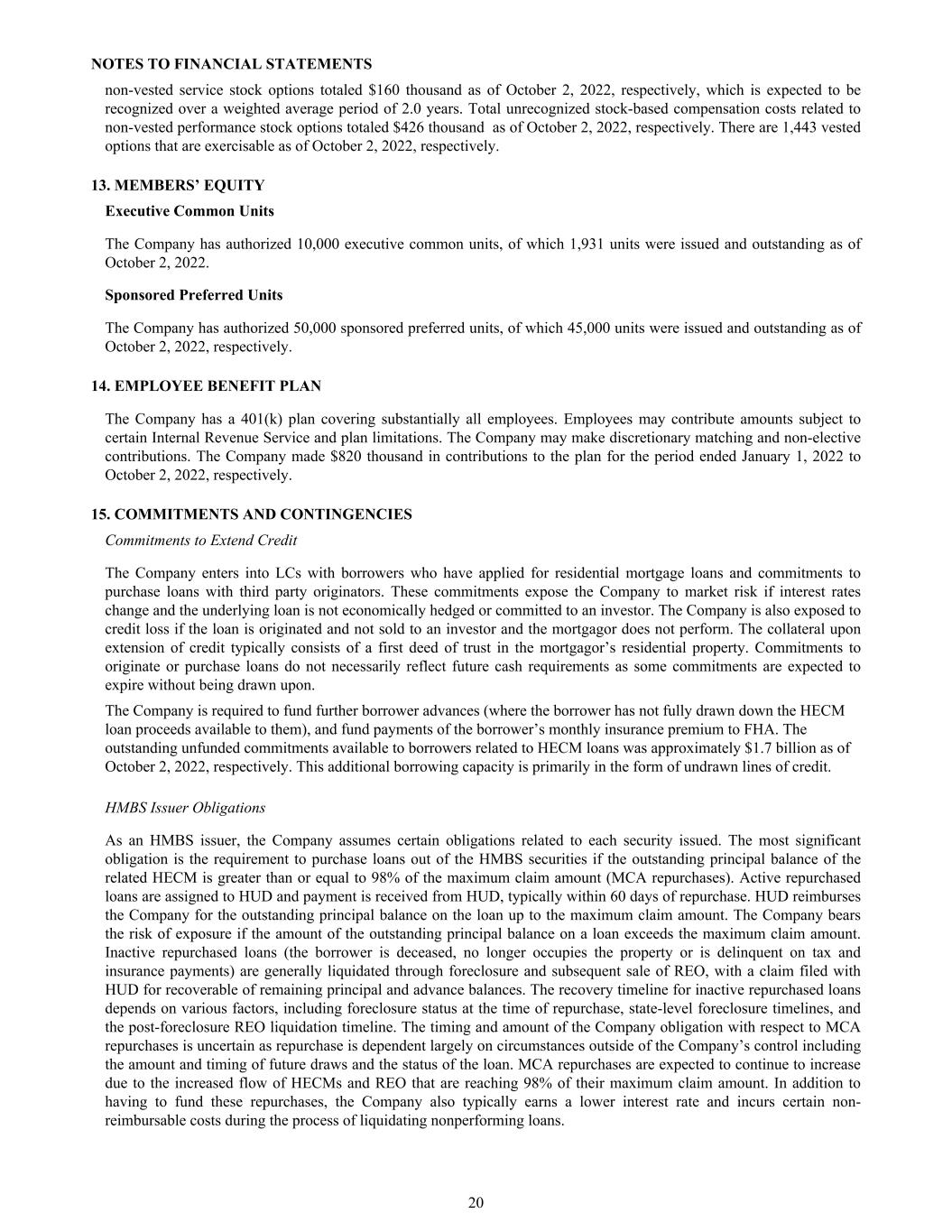
non-vested service stock options totaled $160 thousand as of October 2, 2022, respectively, which is expected to be recognized over a weighted average period of 2.0 years. Total unrecognized stock-based compensation costs related to non-vested performance stock options totaled $426 thousand as of October 2, 2022, respectively. There are 1,443 vested options that are exercisable as of October 2, 2022, respectively. 13. MEMBERS’ EQUITY Executive Common Units The Company has authorized 10,000 executive common units, of which 1,931 units were issued and outstanding as of October 2, 2022. Sponsored Preferred Units The Company has authorized 50,000 sponsored preferred units, of which 45,000 units were issued and outstanding as of October 2, 2022, respectively. 14. EMPLOYEE BENEFIT PLAN The Company has a 401(k) plan covering substantially all employees. Employees may contribute amounts subject to certain Internal Revenue Service and plan limitations. The Company may make discretionary matching and non-elective contributions. The Company made $820 thousand in contributions to the plan for the period ended January 1, 2022 to October 2, 2022, respectively. 15. COMMITMENTS AND CONTINGENCIES Commitments to Extend Credit The Company enters into LCs with borrowers who have applied for residential mortgage loans and commitments to purchase loans with third party originators. These commitments expose the Company to market risk if interest rates change and the underlying loan is not economically hedged or committed to an investor. The Company is also exposed to credit loss if the loan is originated and not sold to an investor and the mortgagor does not perform. The collateral upon extension of credit typically consists of a first deed of trust in the mortgagor’s residential property. Commitments to originate or purchase loans do not necessarily reflect future cash requirements as some commitments are expected to expire without being drawn upon. The Company is required to fund further borrower advances (where the borrower has not fully drawn down the HECM loan proceeds available to them), and fund payments of the borrower’s monthly insurance premium to FHA. The outstanding unfunded commitments available to borrowers related to HECM loans was approximately $1.7 billion as of October 2, 2022, respectively. This additional borrowing capacity is primarily in the form of undrawn lines of credit. HMBS Issuer Obligations As an HMBS issuer, the Company assumes certain obligations related to each security issued. The most significant obligation is the requirement to purchase loans out of the HMBS securities if the outstanding principal balance of the related HECM is greater than or equal to 98% of the maximum claim amount (MCA repurchases). Active repurchased loans are assigned to HUD and payment is received from HUD, typically within 60 days of repurchase. HUD reimburses the Company for the outstanding principal balance on the loan up to the maximum claim amount. The Company bears the risk of exposure if the amount of the outstanding principal balance on a loan exceeds the maximum claim amount. Inactive repurchased loans (the borrower is deceased, no longer occupies the property or is delinquent on tax and insurance payments) are generally liquidated through foreclosure and subsequent sale of REO, with a claim filed with HUD for recoverable of remaining principal and advance balances. The recovery timeline for inactive repurchased loans depends on various factors, including foreclosure status at the time of repurchase, state-level foreclosure timelines, and the post-foreclosure REO liquidation timeline. The timing and amount of the Company obligation with respect to MCA repurchases is uncertain as repurchase is dependent largely on circumstances outside of the Company’s control including the amount and timing of future draws and the status of the loan. MCA repurchases are expected to continue to increase due to the increased flow of HECMs and REO that are reaching 98% of their maximum claim amount. In addition to having to fund these repurchases, the Company also typically earns a lower interest rate and incurs certain non- reimbursable costs during the process of liquidating nonperforming loans. NOTES TO FINANCIAL STATEMENTS 20
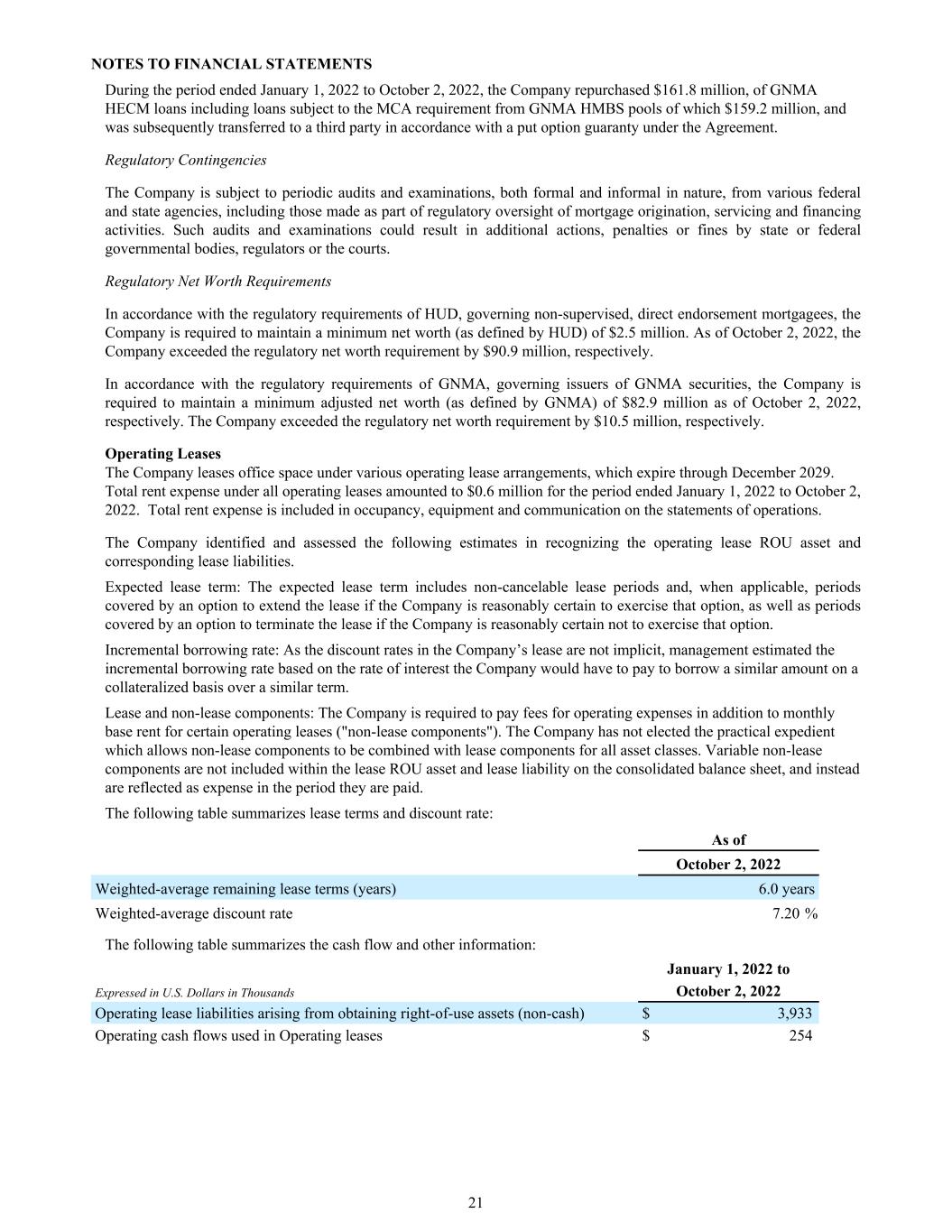
During the period ended January 1, 2022 to October 2, 2022, the Company repurchased $161.8 million, of GNMA HECM loans including loans subject to the MCA requirement from GNMA HMBS pools of which $159.2 million, and was subsequently transferred to a third party in accordance with a put option guaranty under the Agreement. Regulatory Contingencies The Company is subject to periodic audits and examinations, both formal and informal in nature, from various federal and state agencies, including those made as part of regulatory oversight of mortgage origination, servicing and financing activities. Such audits and examinations could result in additional actions, penalties or fines by state or federal governmental bodies, regulators or the courts. Regulatory Net Worth Requirements In accordance with the regulatory requirements of HUD, governing non-supervised, direct endorsement mortgagees, the Company is required to maintain a minimum net worth (as defined by HUD) of $2.5 million. As of October 2, 2022, the Company exceeded the regulatory net worth requirement by $90.9 million, respectively. In accordance with the regulatory requirements of GNMA, governing issuers of GNMA securities, the Company is required to maintain a minimum adjusted net worth (as defined by GNMA) of $82.9 million as of October 2, 2022, respectively. The Company exceeded the regulatory net worth requirement by $10.5 million, respectively. Operating Leases The Company leases office space under various operating lease arrangements, which expire through December 2029. Total rent expense under all operating leases amounted to $0.6 million for the period ended January 1, 2022 to October 2, 2022. Total rent expense is included in occupancy, equipment and communication on the statements of operations. The Company identified and assessed the following estimates in recognizing the operating lease ROU asset and corresponding lease liabilities. Expected lease term: The expected lease term includes non-cancelable lease periods and, when applicable, periods covered by an option to extend the lease if the Company is reasonably certain to exercise that option, as well as periods covered by an option to terminate the lease if the Company is reasonably certain not to exercise that option. Incremental borrowing rate: As the discount rates in the Company’s lease are not implicit, management estimated the incremental borrowing rate based on the rate of interest the Company would have to pay to borrow a similar amount on a collateralized basis over a similar term. Lease and non-lease components: The Company is required to pay fees for operating expenses in addition to monthly base rent for certain operating leases ("non-lease components"). The Company has not elected the practical expedient which allows non-lease components to be combined with lease components for all asset classes. Variable non-lease components are not included within the lease ROU asset and lease liability on the consolidated balance sheet, and instead are reflected as expense in the period they are paid. The following table summarizes lease terms and discount rate: As of October 2, 2022 Weighted-average remaining lease terms (years) 6.0 years Weighted-average discount rate 7.20 % The following table summarizes the cash flow and other information: January 1, 2022 to Expressed in U.S. Dollars in Thousands October 2, 2022 Operating lease liabilities arising from obtaining right-of-use assets (non-cash) $ 3,933 Operating cash flows used in Operating leases $ 254 NOTES TO FINANCIAL STATEMENTS 21
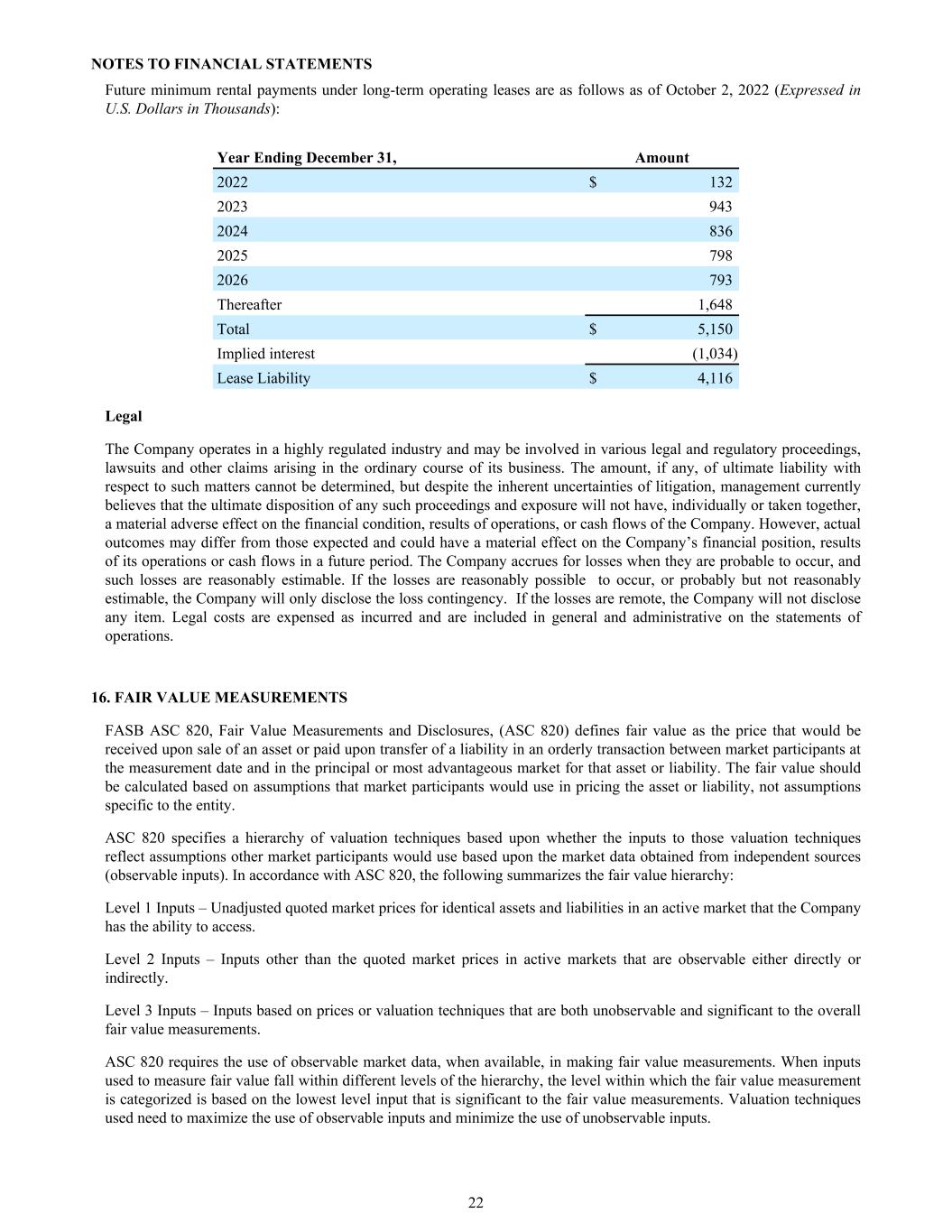
Future minimum rental payments under long-term operating leases are as follows as of October 2, 2022 (Expressed in U.S. Dollars in Thousands): Year Ending December 31, Amount 2022 $ 132 2023 943 2024 836 2025 798 2026 793 Thereafter 1,648 Total $ 5,150 Implied interest (1,034) Lease Liability $ 4,116 Legal The Company operates in a highly regulated industry and may be involved in various legal and regulatory proceedings, lawsuits and other claims arising in the ordinary course of its business. The amount, if any, of ultimate liability with respect to such matters cannot be determined, but despite the inherent uncertainties of litigation, management currently believes that the ultimate disposition of any such proceedings and exposure will not have, individually or taken together, a material adverse effect on the financial condition, results of operations, or cash flows of the Company. However, actual outcomes may differ from those expected and could have a material effect on the Company’s financial position, results of its operations or cash flows in a future period. The Company accrues for losses when they are probable to occur, and such losses are reasonably estimable. If the losses are reasonably possible to occur, or probably but not reasonably estimable, the Company will only disclose the loss contingency. If the losses are remote, the Company will not disclose any item. Legal costs are expensed as incurred and are included in general and administrative on the statements of operations. 16. FAIR VALUE MEASUREMENTS FASB ASC 820, Fair Value Measurements and Disclosures, (ASC 820) defines fair value as the price that would be received upon sale of an asset or paid upon transfer of a liability in an orderly transaction between market participants at the measurement date and in the principal or most advantageous market for that asset or liability. The fair value should be calculated based on assumptions that market participants would use in pricing the asset or liability, not assumptions specific to the entity. ASC 820 specifies a hierarchy of valuation techniques based upon whether the inputs to those valuation techniques reflect assumptions other market participants would use based upon the market data obtained from independent sources (observable inputs). In accordance with ASC 820, the following summarizes the fair value hierarchy: Level 1 Inputs – Unadjusted quoted market prices for identical assets and liabilities in an active market that the Company has the ability to access. Level 2 Inputs – Inputs other than the quoted market prices in active markets that are observable either directly or indirectly. Level 3 Inputs – Inputs based on prices or valuation techniques that are both unobservable and significant to the overall fair value measurements. ASC 820 requires the use of observable market data, when available, in making fair value measurements. When inputs used to measure fair value fall within different levels of the hierarchy, the level within which the fair value measurement is categorized is based on the lowest level input that is significant to the fair value measurements. Valuation techniques used need to maximize the use of observable inputs and minimize the use of unobservable inputs. NOTES TO FINANCIAL STATEMENTS 22
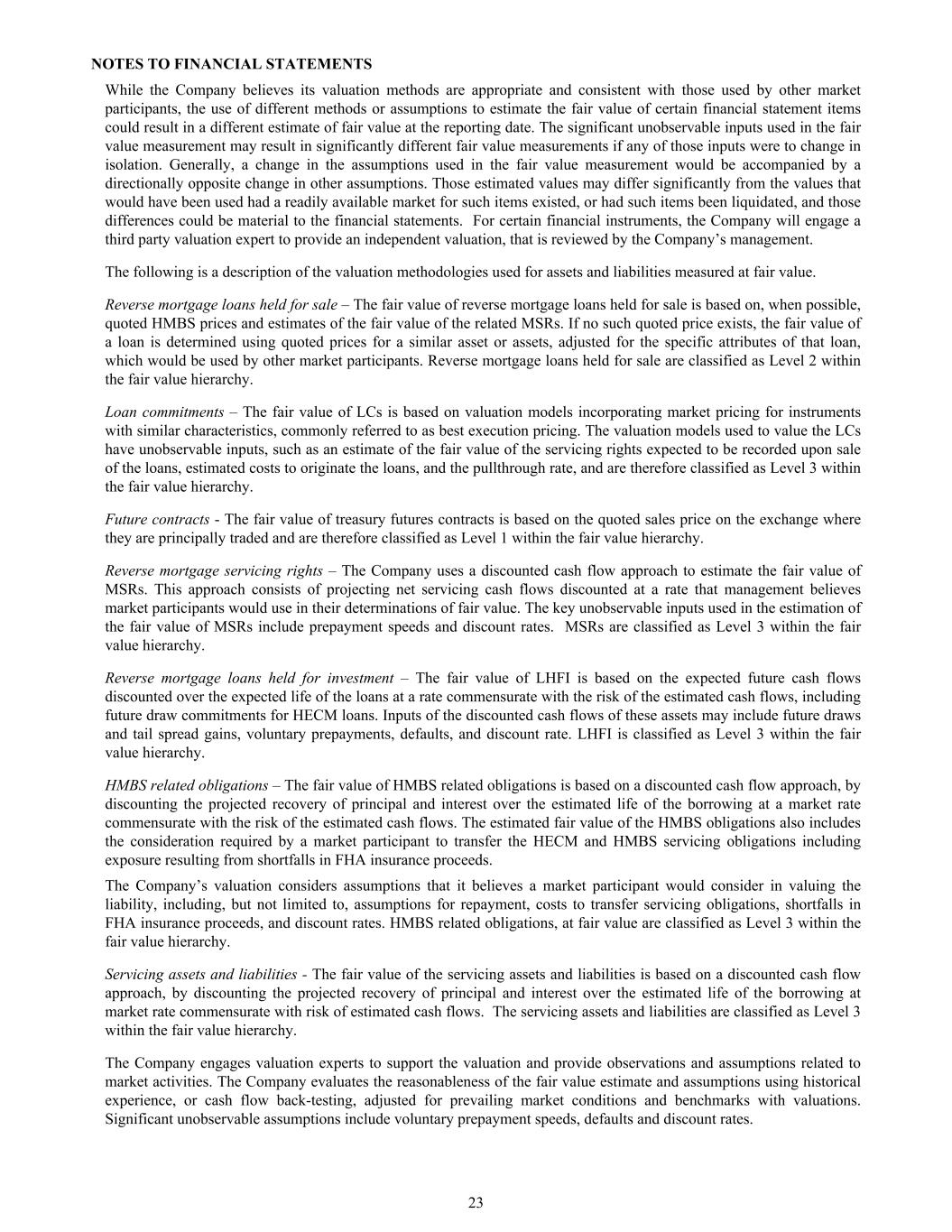
While the Company believes its valuation methods are appropriate and consistent with those used by other market participants, the use of different methods or assumptions to estimate the fair value of certain financial statement items could result in a different estimate of fair value at the reporting date. The significant unobservable inputs used in the fair value measurement may result in significantly different fair value measurements if any of those inputs were to change in isolation. Generally, a change in the assumptions used in the fair value measurement would be accompanied by a directionally opposite change in other assumptions. Those estimated values may differ significantly from the values that would have been used had a readily available market for such items existed, or had such items been liquidated, and those differences could be material to the financial statements. For certain financial instruments, the Company will engage a third party valuation expert to provide an independent valuation, that is reviewed by the Company’s management. The following is a description of the valuation methodologies used for assets and liabilities measured at fair value. Reverse mortgage loans held for sale – The fair value of reverse mortgage loans held for sale is based on, when possible, quoted HMBS prices and estimates of the fair value of the related MSRs. If no such quoted price exists, the fair value of a loan is determined using quoted prices for a similar asset or assets, adjusted for the specific attributes of that loan, which would be used by other market participants. Reverse mortgage loans held for sale are classified as Level 2 within the fair value hierarchy. Loan commitments – The fair value of LCs is based on valuation models incorporating market pricing for instruments with similar characteristics, commonly referred to as best execution pricing. The valuation models used to value the LCs have unobservable inputs, such as an estimate of the fair value of the servicing rights expected to be recorded upon sale of the loans, estimated costs to originate the loans, and the pullthrough rate, and are therefore classified as Level 3 within the fair value hierarchy. Future contracts - The fair value of treasury futures contracts is based on the quoted sales price on the exchange where they are principally traded and are therefore classified as Level 1 within the fair value hierarchy. Reverse mortgage servicing rights – The Company uses a discounted cash flow approach to estimate the fair value of MSRs. This approach consists of projecting net servicing cash flows discounted at a rate that management believes market participants would use in their determinations of fair value. The key unobservable inputs used in the estimation of the fair value of MSRs include prepayment speeds and discount rates. MSRs are classified as Level 3 within the fair value hierarchy. Reverse mortgage loans held for investment – The fair value of LHFI is based on the expected future cash flows discounted over the expected life of the loans at a rate commensurate with the risk of the estimated cash flows, including future draw commitments for HECM loans. Inputs of the discounted cash flows of these assets may include future draws and tail spread gains, voluntary prepayments, defaults, and discount rate. LHFI is classified as Level 3 within the fair value hierarchy. HMBS related obligations – The fair value of HMBS related obligations is based on a discounted cash flow approach, by discounting the projected recovery of principal and interest over the estimated life of the borrowing at a market rate commensurate with the risk of the estimated cash flows. The estimated fair value of the HMBS obligations also includes the consideration required by a market participant to transfer the HECM and HMBS servicing obligations including exposure resulting from shortfalls in FHA insurance proceeds. The Company’s valuation considers assumptions that it believes a market participant would consider in valuing the liability, including, but not limited to, assumptions for repayment, costs to transfer servicing obligations, shortfalls in FHA insurance proceeds, and discount rates. HMBS related obligations, at fair value are classified as Level 3 within the fair value hierarchy. Servicing assets and liabilities - The fair value of the servicing assets and liabilities is based on a discounted cash flow approach, by discounting the projected recovery of principal and interest over the estimated life of the borrowing at market rate commensurate with risk of estimated cash flows. The servicing assets and liabilities are classified as Level 3 within the fair value hierarchy. The Company engages valuation experts to support the valuation and provide observations and assumptions related to market activities. The Company evaluates the reasonableness of the fair value estimate and assumptions using historical experience, or cash flow back-testing, adjusted for prevailing market conditions and benchmarks with valuations. Significant unobservable assumptions include voluntary prepayment speeds, defaults and discount rates. NOTES TO FINANCIAL STATEMENTS 23
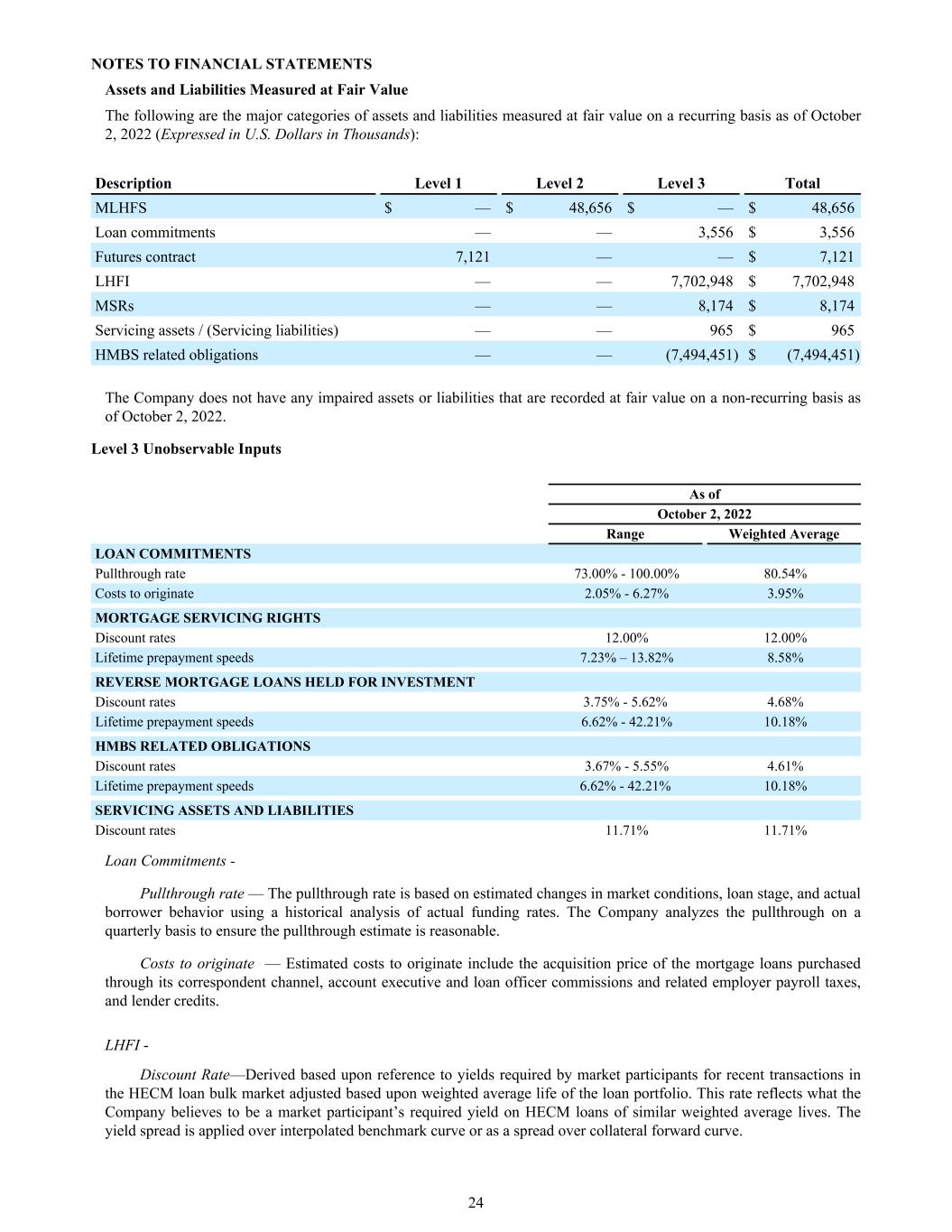
Assets and Liabilities Measured at Fair Value The following are the major categories of assets and liabilities measured at fair value on a recurring basis as of October 2, 2022 (Expressed in U.S. Dollars in Thousands): Description Level 1 Level 2 Level 3 Total MLHFS $ — $ 48,656 $ — $ 48,656 Loan commitments — — 3,556 $ 3,556 Futures contract 7,121 — — $ 7,121 LHFI — — 7,702,948 $ 7,702,948 MSRs — — 8,174 $ 8,174 Servicing assets / (Servicing liabilities) — — 965 $ 965 HMBS related obligations — — (7,494,451) $ (7,494,451) The Company does not have any impaired assets or liabilities that are recorded at fair value on a non-recurring basis as of October 2, 2022. Level 3 Unobservable Inputs As of October 2, 2022 Range Weighted Average LOAN COMMITMENTS Pullthrough rate 73.00% - 100.00% 80.54% Costs to originate 2.05% - 6.27% 3.95% MORTGAGE SERVICING RIGHTS Discount rates 12.00% 12.00% Lifetime prepayment speeds 7.23% – 13.82% 8.58% REVERSE MORTGAGE LOANS HELD FOR INVESTMENT Discount rates 3.75% - 5.62% 4.68% Lifetime prepayment speeds 6.62% - 42.21% 10.18% HMBS RELATED OBLIGATIONS Discount rates 3.67% - 5.55% 4.61% Lifetime prepayment speeds 6.62% - 42.21% 10.18% SERVICING ASSETS AND LIABILITIES Discount rates 11.71% 11.71% Loan Commitments - Pullthrough rate — The pullthrough rate is based on estimated changes in market conditions, loan stage, and actual borrower behavior using a historical analysis of actual funding rates. The Company analyzes the pullthrough on a quarterly basis to ensure the pullthrough estimate is reasonable. Costs to originate — Estimated costs to originate include the acquisition price of the mortgage loans purchased through its correspondent channel, account executive and loan officer commissions and related employer payroll taxes, and lender credits. LHFI - Discount Rate—Derived based upon reference to yields required by market participants for recent transactions in the HECM loan bulk market adjusted based upon weighted average life of the loan portfolio. This rate reflects what the Company believes to be a market participant’s required yield on HECM loans of similar weighted average lives. The yield spread is applied over interpolated benchmark curve or as a spread over collateral forward curve. NOTES TO FINANCIAL STATEMENTS 24

Lifetime prepayment speeds—The Company projects borrower prepayment rates which considers borrower age and gender and is based on historical termination rates. The outputs of borrower prepayment rates, which include both voluntary and involuntary prepayments, are utilized to anticipate future terminations. Significant increases or decreases in any of these assumptions in isolation could result in a materially lower or higher fair value. The effects of changes in the assumptions used to value the LHFI, excluding future draw commitments, are largely offset by the effects of changes in the assumptions used to value the HMBS related obligations, at fair value that are associated with these loans. MSRs - Discount Rate - Derived based upon reference to yields derived from expected returns in the MSR market. This rate reflects what the Company believes to be a market participant’s required yield. Prepayment speeds—The conditional repayment rate curve that considers borrower age and gender is based on historical termination rates.The outputs of borrower prepayment rates, which include both voluntary and involuntary prepayments, are utilized to anticipate future terminations. HMBS related obligations - Lifetime prepayment speeds—The conditional repayment rate curve that considers borrower age and gender is based on historical termination rates. Discount Rates—Derived based on an assessment of current market yields and spreads that a market participant would consider for entering into an obligation to pass FHA insured cash flows through to holders of the HMBS beneficial interests. Yield spread applied over interpolated benchmark curve or as a spread over collateral forward curve. Servicing assets and liabilities - Discount Rates—Derived based on an assessment of current market yields and spreads that a market participant would consider for entering into an obligation to pass FHA insured cash flows through to holders of the HMBS beneficial interests. Yield spread applied over interpolated benchmark curve or as a spread over collateral forward curve. Level 3 Reconciliation A reconciliation from the beginning balances to the ending balances of MSRs, LHFI, HMBS Related Obligations, LC servicing assets and liabilities that we measure at fair value on a recurring basis is disclosed in Note 4 - Loan commitments, at fair value, Note 6 - Reverse mortgage servicing rights, at fair value, and Note 7 - Reverse mortgage loans held for investments, at fair value, respectively. At October 2, 2022, the Company had no transfer from level 3 to Level 2 or Level 2 to Level 3 assets or liabilities. Fair Value of Other Financial Instruments Due to their short-term nature, the carrying value of cash and cash equivalents, escrow cash, restricted cash, certificate of deposit, short-term receivables, short-term payables, warehouse line of credit agreements and other financing facilities approximate their fair value as of October 2, 2022, respectively. Warehouse line of credit agreements rates are based on variable rates, and as such, the fair value approximate their fair value as of October 2, 2022, respectively. 17. CONCENTRATION OF RISK Concentration of credit risk associated with reverse mortgage loans held for investment and reverse mortgage loans held for sale are limited due to the large number of customers and their dispersion across many geographic areas. The table below provides the percentage of reverse mortgage loans in the Company’s balance sheet by the location in which the home securing the loan is located and is based on their remaining unpaid principal balance. Any state that has less than five percent interest is included in “Other”. NOTES TO FINANCIAL STATEMENTS 25
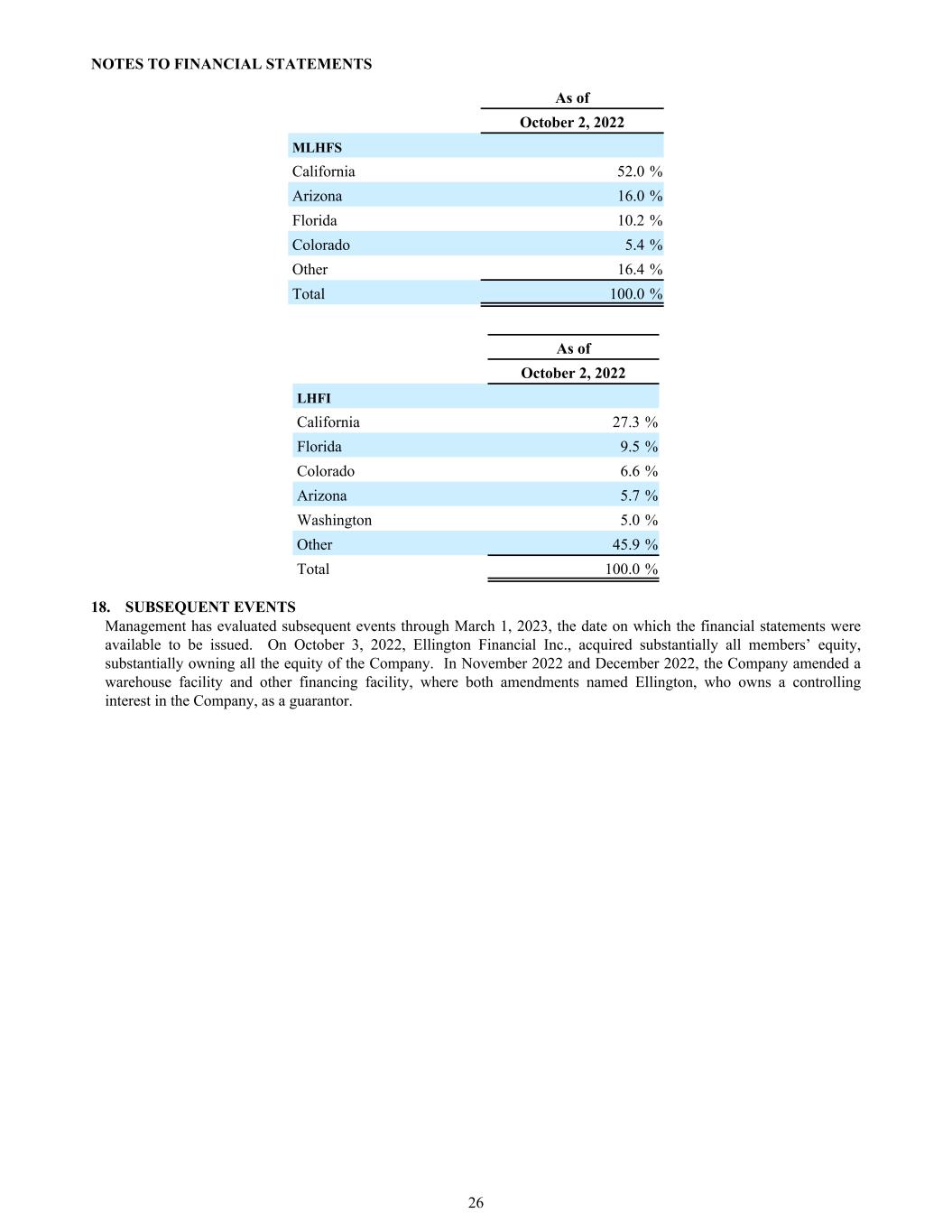
As of October 2, 2022 MLHFS California 52.0 % Arizona 16.0 % Florida 10.2 % Colorado 5.4 % Other 16.4 % Total 100.0 % As of October 2, 2022 LHFI California 27.3 % Florida 9.5 % Colorado 6.6 % Arizona 5.7 % Washington 5.0 % Other 45.9 % Total 100.0 % 18. SUBSEQUENT EVENTS Management has evaluated subsequent events through March 1, 2023, the date on which the financial statements were available to be issued. On October 3, 2022, Ellington Financial Inc., acquired substantially all members’ equity, substantially owning all the equity of the Company. In November 2022 and December 2022, the Company amended a warehouse facility and other financing facility, where both amendments named Ellington, who owns a controlling interest in the Company, as a guarantor. NOTES TO FINANCIAL STATEMENTS 26

























